TRENDNET TEW673GRU 300Mbps Concurrent Dual Band Wireless N Gigabit Router User Manual
TRENDNET, Inc. 300Mbps Concurrent Dual Band Wireless N Gigabit Router
TRENDNET >
Contents
- 1. Manual Part 1
- 2. Manual Part 2
Manual Part 1
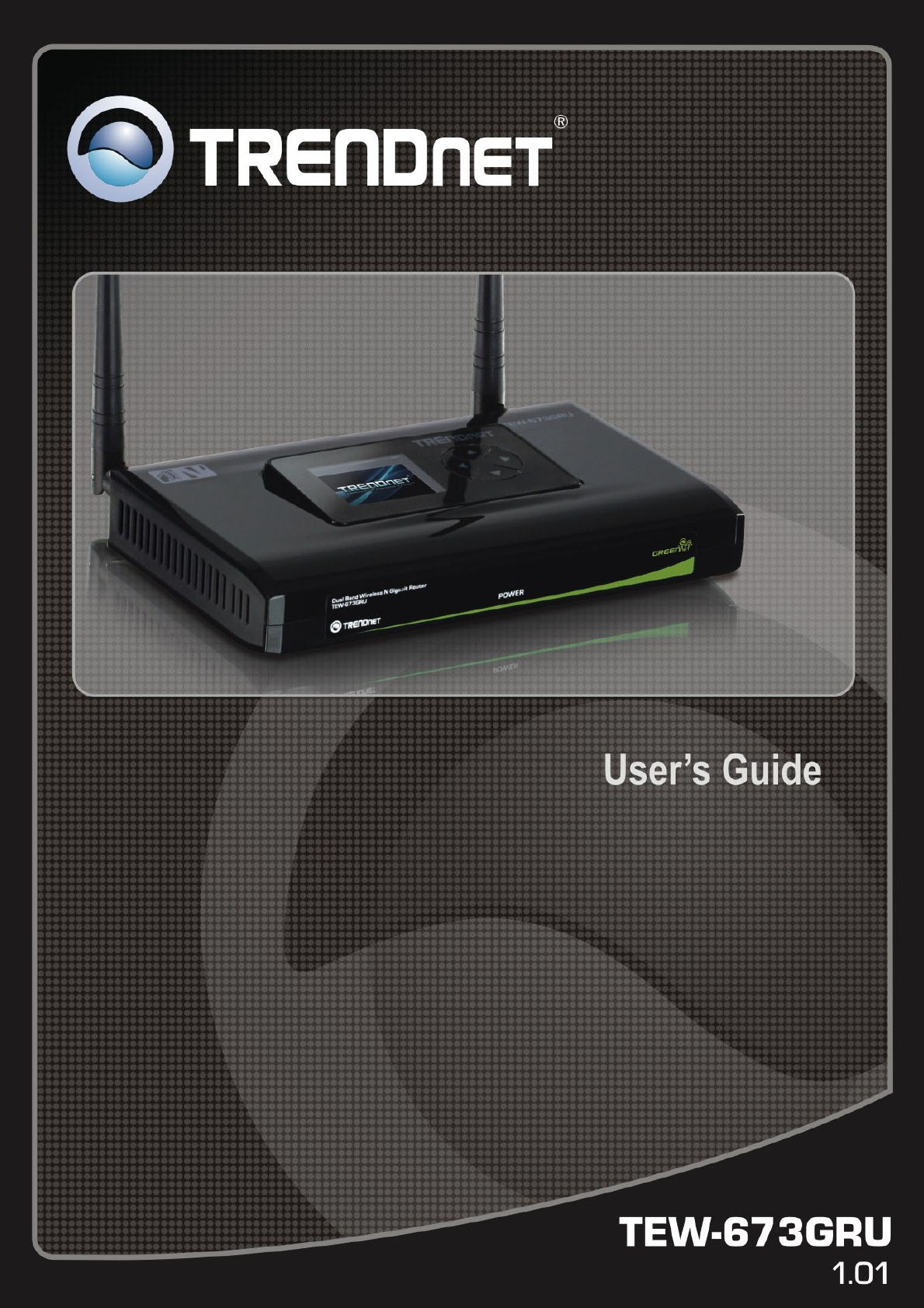
i

ii
Federal Communication Commission Interference Statement
This equipment has been tested and found to comply with the limits for a Class B digital device, pursuant to Part 15 of the
FCC Rules. These limits are designed to provide reasonable protection against harmful interference when the equipment
is operated in a commercial environment. This equipment generates, uses and can radiate radio frequency energy and, if
not installed and used in accordance with the instructions, may cause harmful interference to radio communications.
Operation of this equipment in a residential area is likely to cause harmful interference in which case the user will be
required to correct the interference at his own expense.
If this equipment does cause harmful interference to radio or television reception, which can be determined by turning the
equipment off and on, the user is encouraged to try to correct the interference by one of the following measures:
- Reorient or relocate the receiving antenna.
- Increase the separation between the equipment and receiver.
- Connect the equipment into an outlet on a circuit different from that to which the receiver is connected.
- Consult the dealer or an experienced radio/TV technician for help.
FCC Caution: Any changes or modifications not expressly approved by the party responsible for compliance could void
the user's authority to operate this equipment.
For operation within 5.15 ~ 5.25GHz frequency range, it is restricted to indoor environment.
This device complies with Part 15 of the FCC Rules. Operation is subject to the following two conditions: (1) This device
may not cause harmful interference, and (2) this device must accept any interference received, including interference that
may cause undesired operation.
IMPORTANT NOTE:
Radiation Exposure Statement:
This equipment complies with FCC radiation exposure limits set forth for an uncontrolled environment. This equipment
should be installed and operated with minimum distance 20cm between the radiator & your body.
This transmitter must not be co-located or operating in conjunction with any other antenna or transmitter.
The availability of some specific channels and/or operational frequency bands are country dependent and are firmware
programmed at the factory to match the intended destination. The firmware setting is not accessible by the end user.

iii
Europe – EU Declaration of Conformity
This device complies with the essential requirements of the R&TTE Directive 1999/5/EC. The following test methods have
been applied in order to prove presumption of conformity with the essential requirements of the R&TTE Directive
1999/5/EC:
EN60950-1: 2006
Safety of Information Technology Equipment
EN 50385: 2002
Product standard to demonstrate the compliance of radio base stations and fixed terminal stations for wireless
telecommunication systems with the basic restrictions or the reference levels related to human exposure to radio
frequency electromagnetic fields (110MHz - 40 GHz) - General public
EN 300 328 V1.7.1 (2006-10)
Electromagnetic compatibility and Radio spectrum Matters (ERM); Wideband transmission systems; Data transmission
equipment operating in the 2,4 GHz ISM band and using wide band modulation techniques; Harmonized EN covering
essential requirements under article 3.2 of the R&TTE Directive
EN 301 893 V1.4.1: (2007-07)
Broadband Radio Access Networks (BRAN); 5 GHz high performance RLAN; Harmonized EN covering essential
requirements of article 3.2 of the R&TTE Directive
EN 301 489-1 V1.8.1 (2008-04)
Electromagnetic compatibility and Radio Spectrum Matters (ERM); ElectroMagnetic Compatibility (EMC) standard for
radio equipment and services; Part 1: Common technical requirements
EN 301 489-17 V1.3.2 (2008-04)
Electromagnetic compatibility and Radio spectrum Matters (ERM); ElectroMagnetic Compatibility (EMC) standard for
radio equipment and services; Part 17: Specific conditions for 2,4 GHz wideband transmission systems and 5 GHz high
performance RLAN equipment
This device is a 2.4 GHz wideband transmission system (transceiver), intended for use in all EU member states and
EFTA countries, except in France and Italy where restrictive use applies.
In Italy the end-user should apply for a license at the national spectrum authorities in order to obtain authorization to use
the device for setting up outdoor radio links and/or for supplying public access to telecommunications and/or network
services.
This device may not be used for setting up outdoor radio links in France and in some areas the RF output power may be
limited to 10 mW EIRP in the frequency range of 2454 – 2483.5 MHz. For detailed information the end-user should
contact the national spectrum authority in France.
0560
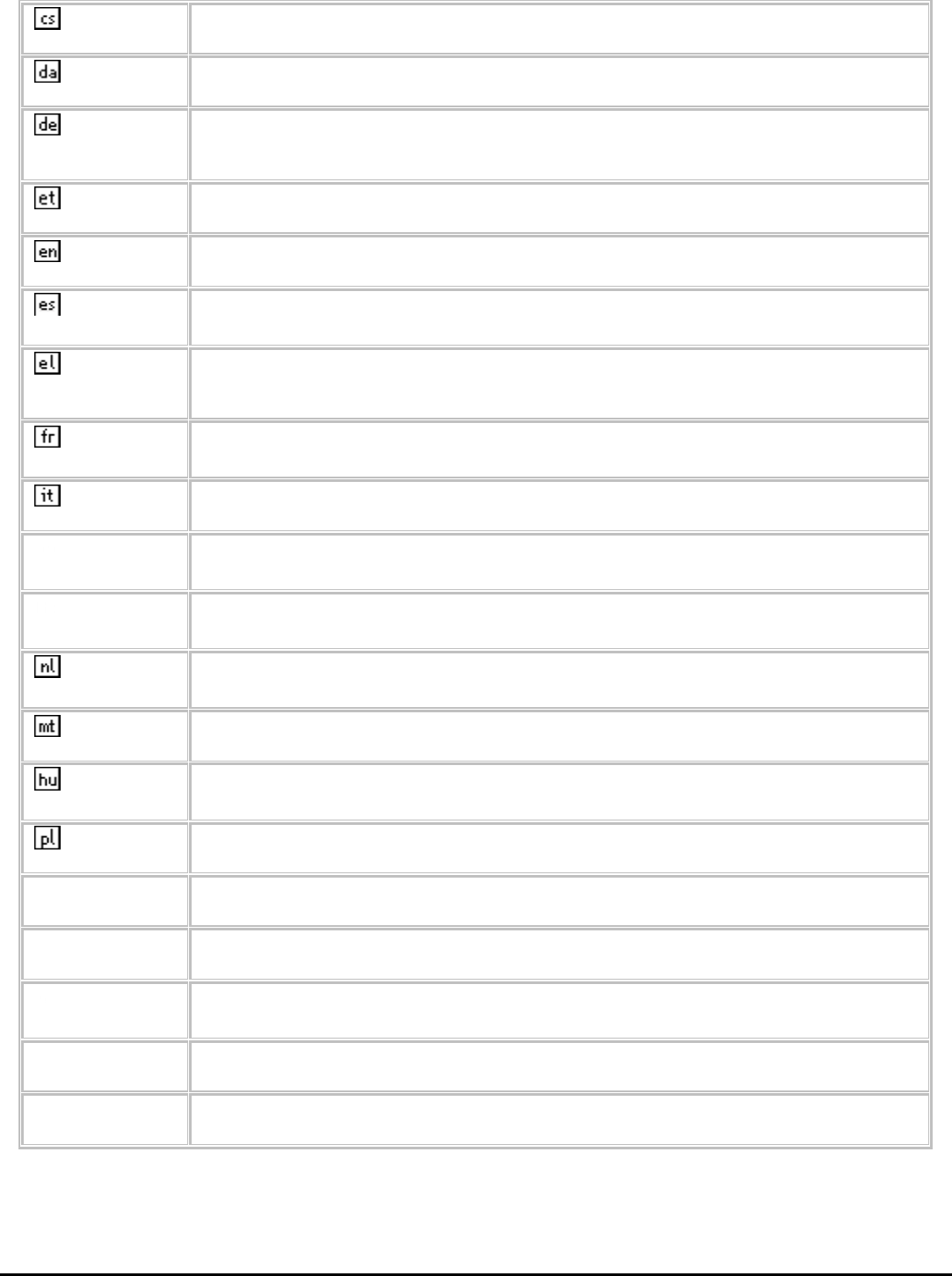
iv
Česky [Czech] TRENDware tímto prohlašuje, že tento TEW-673GRU je ve shodě se základními požadavky a dalšími
příslušnými ustanoveními směrnice 1999/5/ES.
Dansk [Danish] Undertegnede TRENDware erklærer herved, at følgende udstyr TEW-673GRU overholder de
væsentlige krav og øvrige relevante krav i direktiv 1999/5/EF.
Deutsch
[German]
Hiermit erklärt TRENDware, dass sich das Gerät TEW-673GRU in Übereinstimmung mit den
grundlegenden Anforderungen und den übrigen einschlägigen Bestimmungen der Richtlinie
1999/5/EG befindet.
Eesti [Estonian] Käesolevaga kinnitab TRENDware seadme TEW-673GRU vastavust direktiivi 1999/5/EÜ
põhinõuetele ja nimetatud direktiivist tulenevatele teistele asjakohastele sätetele.
English Hereby, TRENDware declares that this TEW-673GRU is in compliance with the essential
requirements and other relevant provisions of Directive 1999/5/EC.
Español
[Spanish]
Por medio de la presente TRENDware declara que el TEW-673GRU cumple con los requisitos
esenciales y cualesquiera otras disposiciones aplicables o exigibles de la Directiva 1999/5/CE.
Ελληνική
[Greek]
ΜΕ ΤΗΝ ΠΑΡΟΥΣΑ TRENDware ∆ΗΛΩΝΕΙ ΟΤΙ TEW-673GRU ΣΥΜΜΟΡΦΩΝΕΤΑΙ ΠΡΟΣ ΤΙΣ
ΟΥΣΙΩ∆ΕΙΣ ΑΠΑΙΤΗΣΕΙΣ ΚΑΙ ΤΙΣ ΛΟΙΠΕΣ ΣΧΕΤΙΚΕΣ ∆ΙΑΤΑΞΕΙΣ ΤΗΣ Ο∆ΗΓΙΑΣ
1999/5/ΕΚ.
Français
[French]
Par la présente TRENDware déclare que l'appareil TEW-673GRU est conforme aux exigences
essentielles et aux autres dispositions pertinentes de la directive 1999/5/CE.
Italiano [Italian] Con la presente TRENDware dichiara che questo TEW-673GRU è conforme ai requisiti essenziali ed
alle altre disposizioni pertinenti stabilite dalla direttiva 1999/5/CE.
Latviski
[Latvian]
Ar šo TRENDware deklarē, ka TEW-673GRU atbilst Direktīvas 1999/5/EK būtiskajām prasībām un
citiem ar to saistītajiem noteikumiem.
Lietuvių
[Lithuanian]
Šiuo TRENDware deklaruoja, kad šis TEW-673GRU] atitinka esminius reikalavimus ir kitas
1999/5/EB Direktyvos nuostatas.
Nederlands
[Dutch]
Hierbij verklaart TRENDware dat het toestel TEW-673GRU in overeenstemming is met de essentiële
eisen en de andere relevante bepalingen van richtlijn 1999/5/EG.
Malti [Maltese] Hawnhekk, TRENDware, jiddikjara li dan TEW-673GRU jikkonforma mal-ħtiġijiet essenzjali u ma
provvedimenti oħrajn relevanti li hemm fid-Dirrettiva 1999/5/EC.
Magyar
[Hungarian]
Alulírott, TRENDware nyilatkozom, hogy a TEW-673GRU megfelel a vonatkozó alapvetõ
követelményeknek és az 1999/5/EC irányelv egyéb elõírásainak.
Polski [Polish] Niniejszym TRENDware oświadcza, że TEW-673GRU jest zgodny z zasadniczymi wymogami oraz
pozostałymi stosownymi postanowieniami Dyrektywy 1999/5/EC.
Português
[Portuguese] TRENDware declara que este TEW-673GRU está conforme com os requisitos essenciais e outras
disposições da Directiva 1999/5/CE.
Slovensko
[Slovenian] TRENDware izjavlja, da je ta TEW-673GRU v skladu z bistvenimi zahtevami in ostalimi relevantnimi
določili direktive 1999/5/ES.
Slovensky
[Slovak]
TRENDware týmto vyhlasuje, že TEW-673GRU spĺňa základné požiadavky a všetky príslušné
ustanovenia Smernice 1999/5/ES.
Suomi [Finnish] TRENDware vakuuttaa täten että TEW-673GRU tyyppinen laite on direktiivin 1999/5/EY oleellisten
vaatimusten ja sitä koskevien direktiivin muiden ehtojen mukainen.
Svenska [Swedish] Härmed intygar TRENDware att denna TEW-673GRU står I överensstämmelse med de väsentliga
egenskapskrav och övriga relevanta bestämmelser som framgår av direktiv 1999/5/EG.

v
TABLE OF CONTENT
ABOUT THIS GUIDE .................................................................................... 1
Purpose ................................................................................................................................................................................................. 1
Terms/Usage ......................................................................................................................................................................................... 1
Overview of this User’s Guide.............................................................................................................................................................. 1
INTRODUCTION ........................................................................................... 2
Applications:......................................................................................................................................................................................... 2
Supported Features: .............................................................................................................................................................................. 3
UNPACKING AND SETUP.............................................................................. 4
Unpacking............................................................................................................................................................................................. 4
Setup ..................................................................................................................................................................................................... 4
Wireless Performance Considerations .................................................................................................................................................. 5
HARDWARE INSTALLATION......................................................................... 6
Front Panel and Top Panel.................................................................................................................................................................... 6
Rear Panel............................................................................................................................................................................................. 7
Side Panel ............................................................................................................................................................................................. 8
Hardware connections........................................................................................................................................................................... 9
PC NETWORK TCP/IP SETTING ............................................................... 10
Windows 95/98/ME............................................................................................................................................................................ 10
Windows 2000 .................................................................................................................................................................................... 11
Windows XP / Vista............................................................................................................................................................................ 12
CONFIGURATION....................................................................................... 13
Login to the WLAN Router through Wireless LAN........................................................................................................................... 13
Login to the WLAN Router ................................................................................................................................................................ 13
Using the Web Browser...................................................................................................................................................................... 13
Setup Wizard....................................................................................................................................................................................... 14
Main configuration.............................................................................................................................................................................. 24
LAN & DHCP Server ..................................................................................................................................................................... 24
WAN............................................................................................................................................................................................... 25
Password ......................................................................................................................................................................................... 26
Time................................................................................................................................................................................................ 27
Dynamic DNS................................................................................................................................................................................. 28
Wireless .............................................................................................................................................................................................. 28
Basic................................................................................................................................................................................................ 28
Security ........................................................................................................................................................................................... 31
Advanced ........................................................................................................................................................................................ 34
WIFI Protected Setup...................................................................................................................................................................... 35
Status................................................................................................................................................................................................... 36
Device Information ......................................................................................................................................................................... 36
Log.................................................................................................................................................................................................. 37
Log Setting...................................................................................................................................................................................... 38
Statistic............................................................................................................................................................................................ 39
Wireless .......................................................................................................................................................................................... 40
Routing ............................................................................................................................................................................................... 40
Static ............................................................................................................................................................................................... 40

vi
Dynamic.......................................................................................................................................................................................... 41
Routing Table.................................................................................................................................................................................. 41
Access................................................................................................................................................................................................. 43
Filter................................................................................................................................................................................................ 43
Virtual Server.................................................................................................................................................................................. 46
Special AP....................................................................................................................................................................................... 47
DMZ................................................................................................................................................................................................ 48
Firewall Settings ............................................................................................................................................................................. 49
QoS ................................................................................................................................................................................................. 50
Management........................................................................................................................................................................................ 51
Remote Management ...................................................................................................................................................................... 51
Tools ................................................................................................................................................................................................... 52
Restart ............................................................................................................................................................................................. 52
Settings............................................................................................................................................................................................ 52
Firmware......................................................................................................................................................................................... 53
Ping................................................................................................................................................................................................. 53
USING THE LCD PANEL............................................................................ 55
Main Menu.......................................................................................................................................................................................... 55
Navigation Keys ................................................................................................................................................................................. 55
Device Info Menu ............................................................................................................................................................................... 56
General............................................................................................................................................................................................ 56
Internet............................................................................................................................................................................................ 57
Wireless .......................................................................................................................................................................................... 57
Wired .............................................................................................................................................................................................. 58
Performance Menu.............................................................................................................................................................................. 58
Settings Menu ..................................................................................................................................................................................... 59
Restart ............................................................................................................................................................................................. 60
Reset................................................................................................................................................................................................ 60
Date/Time ....................................................................................................................................................................................... 61
Connected Devices.......................................................................................................................................................................... 61
WPS Menu.......................................................................................................................................................................................... 61
WPS ................................................................................................................................................................................................ 62
Current PIN..................................................................................................................................................................................... 64
USB CONTROL CENTER UTILITY............................................................... 65
Utility.................................................................................................................................................................................................. 65
System............................................................................................................................................................................................. 65
Configure Server............................................................................................................................................................................. 66
Print Sharing ....................................................................................................................................................................................... 66
Auto Connect Printer ...................................................................................................................................................................... 66
Network Scanner................................................................................................................................................................................. 67
Connecting USB Storage Device........................................................................................................................................................ 69
TECHNICAL SPECIFICATIONS ................................................................... 71

1
ABOUT THIS GUIDE
Congratulations on your purchase of this 300Mbps Wireless N Dual Band Gigabit
Router with USB Port. This integrated access device combines Internet gateway
functions with wireless LAN and Fast Ethernet switch. It provides a complete
solution for Internet surfing and office resource sharing, and it is easy to configure
and operate for every user.
Purpose
This manual discusses how to install the 300Mbps Wireless N Dual Band Gigabit
Router with USB Port.
Terms/Usage
In this guide, the term “the WLAN Router” refers to your 300Mbps Wireless N
Dual Band Gigabit Router with USB Port.
Overview of this User’s Guide
Introduction: Describes the 300Mbps Wireless N Dual Band Gigabit Router with
USB Port and its features.
Unpacking and Setup. Helps you get started with the basic installation of the the
300Mbps Wireless N Dual Band Gigabit Router with USB Port.
Identifying External Components: Describes the front panel, rear panel and LED
indicators of the IEEE 802.11b/g/n Wireless Home Router.
Connecting the WLAN Router: Tells how you can connect the WLAN Router to
your xDSL/Cable Modem.
USB Control Center Utility: Describes ways on how to use the utility for
scanning, file sharing and printing.
Technical Specifications: Lists all the technical (general, physical and
environmental, performance and Routers settings) specifications of the WLAN
Router.
Note: Run the CD and follow the steps in the Quick Installation Guide first to setup
your router. If you still have problems after doing so then proceed to the following
paragraphs to install the router with web-based configuration.

2
INTRODUCTION
300Mbps Dual Band Wireless N Gigabit Router
The 300Mbps Dual Band Wireless N Gigabit Router (model TEW-673GRU)
delivers unsurpassed Dual Band wireless speed, coverage, and reliability with up to
14x the speed and 6x the coverage of a wireless g connection*.
Dual Band technology creates two separate 300Mbps wireless n networks at the
same time—one on the 2.4GHz frequency and the other on the less congested
5GHz frequency. A color LCD management interface provides real time
performance, security, and device information thereby reducing the need to login to
the router.
Share content by connecting USB flash drives, hard drives, or printers directly to
two USB ports on the back of the router. Gigabit Ethernet ports offer exceptional
wired throughput performance. Multiple Input Multiple Output (MIMO) antenna
technology reduces wireless dead spots, advanced wireless encryption protects your
digital content, and WMM® Quality of Service (QoS) technology prioritizes
gaming, Internet calls, and video streams. Wi-Fi Protected Setup (WPS) connects
WPS compliant computers at the touch of a button. Wirelessly stream HD
multimedia using the uncongested 5GHz frequency while surfing the Internet using
the 2.4GHz frequency.
Applications:
Broadband Internet access:
Several computers can share one high-speed broadband connection through
wireless or wired (WLAN, LAN and WAN-Internet).
Resource sharing:
Share resources such as printers, scanners and other peripherals.
File sharing:
Exchange data, messages, and distribute files thus making good use of hard disk
space.
Online gaming:
Through the local area network, online gaming and e-commerce services can be
easily setup.
Firewall:
A built-in firewall function — for security and anti-hacking systems.

3
Supported Features:
¾ Compliant with IEEE 802.11n/g/b/a standards
¾ Transmits simultaneous 2.4GHz and 5GHz Wireless Local Area Network
(WLAN) signals (with separate default SSIDs)
¾ 4 x 10/100/1000Mbps Auto-MDIX LAN ports
¾ 1 x 10/100/1000Mbps WAN port (Internet)
¾ 2 x USB 2.0 ports
¾ 1 x Wi-Fi Protected Setup (WPS) button
¾ Color LCD management interface: view device status, local time, network
performance, and additional router management options
¾ Compatible with most popular cable/DSL Internet Service Providers using
Dynamic/Static IP, PPPoE and PPTP
¾ High-speed data rates up to 300Mbps using an IEEE 802.11n connection
¾ Network a USB flash drive, hard drive, or printer using software utility
¾ 2 detachable antennas provide high-speed performance and expansive
wireless coverage
¾ Advanced firewall protection with Network Address Translation (NAT) and
Stateful Packet Inspection (SPI)
¾ Access restriction with Internet Access Control; MAC, Protocol, and Domain
filtering
¾ Virtual server and Application Level Gateway (ALG) services for special
Internet applications
¾ Universal Plug and Play (UPnP) for auto discovery and support for device
configuration of Internet applications
¾ Multiple pass-through sessions for popular VPN applications (IPSec, L2TP,
and PPTP)
¾ Advanced QoS support includes: Uplink speed control, IP prioritization and
Wi-Fi Multimedia (WMM)
¾ One touch wireless security setup using the Wi-Fi Protected Setup (WPS)
button
¾ Complete wireless security with WPA/WPA2-RADIUS, WPA-PSK/WPA2-
PSK, and WEP
¾ USB control center utility (designed for storage devices and print servers )
works with Windows 7/Vista/2000/XP
¾ Coverage up to 100 meters (330ft.) indoor and 300meters (980ft) outdoor
(depends on the environment

4
UNPACKING AND SETUP
This chapter provides unpacking and setup information for the IEEE 300Mbps
Wireless N Dual Band Gigabit Router with USB Port.
Unpacking
Open the box of the WLAN Router and carefully unpack it. The box should contain
the following items:
TEW-673GRU 300Mbps Wireless N Dual Band Gigabit Router with USB Port
CD ROM (Utility/User’s Guide)
Multi-Language Quick Installation Guide
2 x 3dBi gain dipole antenna
Power Adapter (12V DC, 2A)
Cat. 5 Ethernet Cable (1.5m/5ft)
If any item is found missing or damaged, please contact your local reseller for
replacement.
Setup
The setup of the WLAN Router can be performed properly using the following
methods:
The power outlet should be within 1.82 meters (6 feet) of the Broadband Router.
Visually inspect the DC power jack and make sure that it is fully secured to the
power adapter.
Make sure that there is proper heat dissipation and adequate ventilation around
the Broadband Router. Do not place heavy objects on the Broadband Router.
Fix the direction of the antennas. Try to place the Wireless Router in a position
that can best cover your wireless network. Normally, the higher you place the
antenna, the better the performance will be. The antenna’s position enhances the
receiving sensitivity.

5
Wireless Performance Considerations
There are a number of factors that can impact the range of wireless devices.
1. Adjust your wireless devices so that the signal is traveling in a straight path,
rather than at an angle. The more material the signal has to pass through the
more signal you will lose.
2. Keep the number of obstructions to a minimum. Each obstruction can reduce the
range of a wireless device. Position the wireless devices in a manner that will
minimize the amount of obstructions between them.
3. Building materials can have a large impact on your wireless signal. In an indoor
environment, try to position the wireless devices so that the signal passes
through less dense material such as dry wall. Dense materials like metal, solid
wood, glass or even furniture may block or degrade the signal.
4. Antenna orientation can also have a large impact on your wireless signal. Use
the wireless adapter’s site survey tool to determine the best antenna orientation
for your wireless devices.
5. Interference from devices that produce RF (radio frequency) noise can also
impact your signal. Position your wireless devices away from anything that
generates RF noise, such as microwaves, radios and baby monitors.
6. Any device operating on the 2.4GHz frequency will cause interference. Devices
such as 2.4GHz cordless phones or other wireless remotes operating on the
2.4GHz frequency can potentially drop the wireless signal. Although the phone
may not be in use, the base can still transmit wireless signal. Move the phone’s
base station as far away as possible from your wireless devices.
If you are still experiencing low or no signal consider repositioning the wireless
devices or installing additional access points. The use of higher gain antennas may
also provide the necessary coverage depending on the environment.
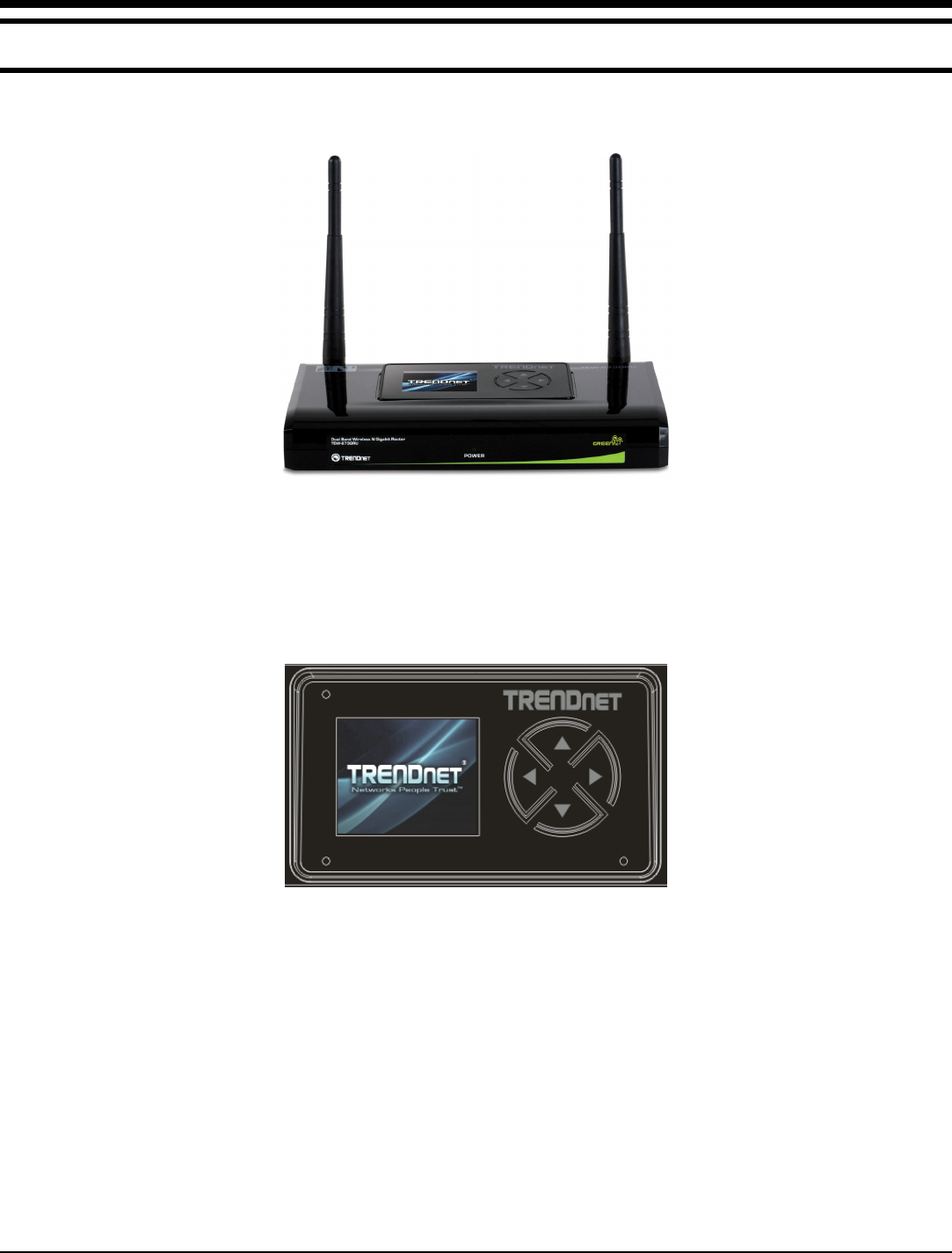
6
HARDWARE INSTALLATION
Front Panel and Top Panel
The figure below shows the front panel of the 300Mbps Wireless N Dual Band
Gigabit Router with USB Port.
Front Panel
POWER LED:
This indicator lights green when the hub is receives power, otherwise it is off.
LCD Screen:
The LED screen displays information regarding the router.
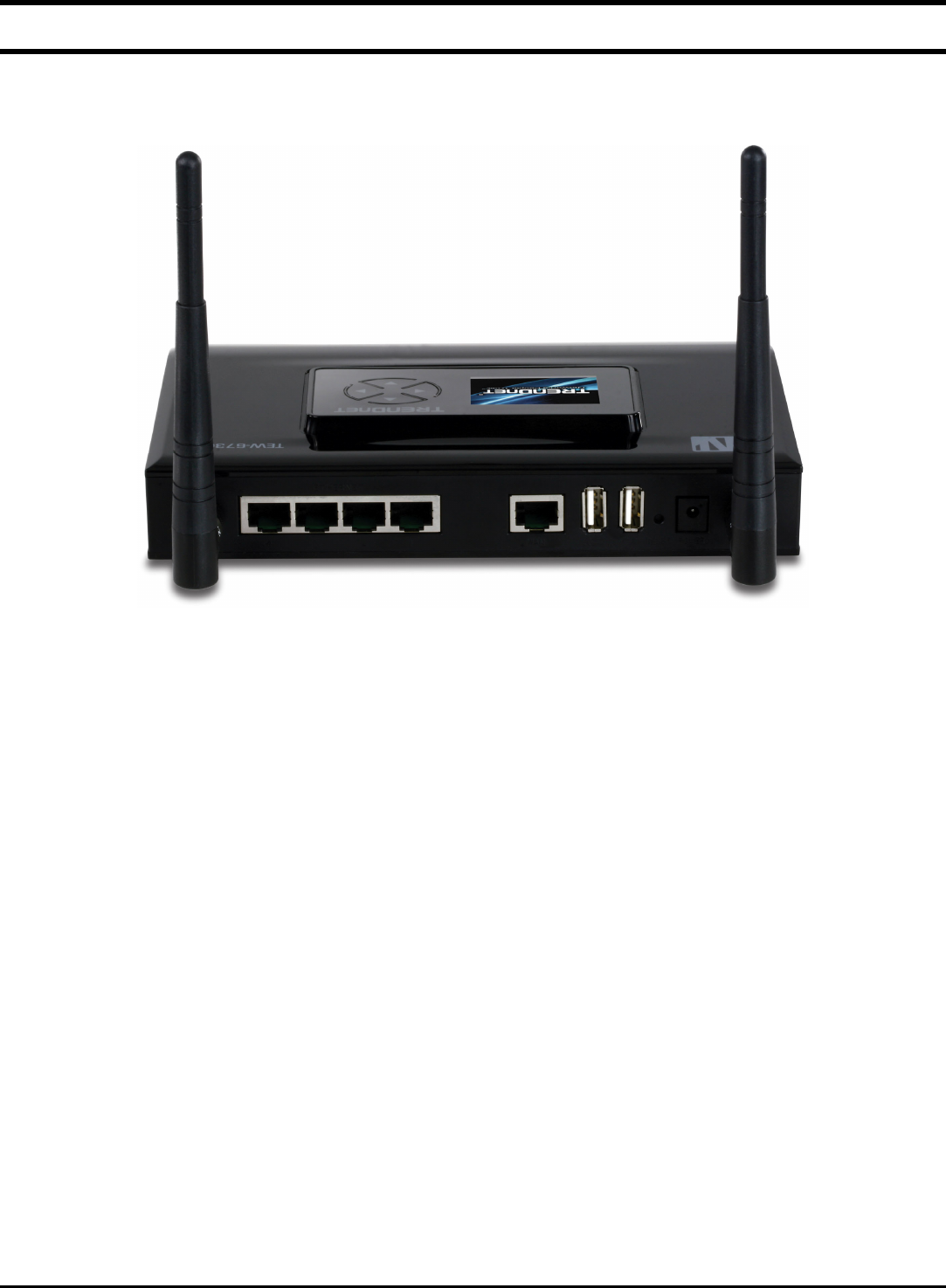
7
Rear Panel
The figure below shows the rear panel of the 300Mbps Wireless N Dual Band
Gigabit Router with USB Port.
Rear Panel
Antenna:
There are two 3dBi gain antennas on the rear panel for wireless connection.
LAN (1-4):
Four 10/100/1000Mbps Auto-MDIX LAN port for connecting 10Mbps, 100Mbps
Ethernet or 10000Mbps Gigabit connections.
WAN:
One 10/100/1000Mbps WAN port that connects to the xDSL/Cable modem for
Internet connectivity.
USB:
Two USB ports to share either USB storage devices or printers over the network.
POWER:
Plug the power adapter to this power jack
RESET:
Use a pin-shaped item to push to reset this device to factory default settings. It will
be a useful tool when the manager forgot the password to login, and needs to
restore the device back to default settings.
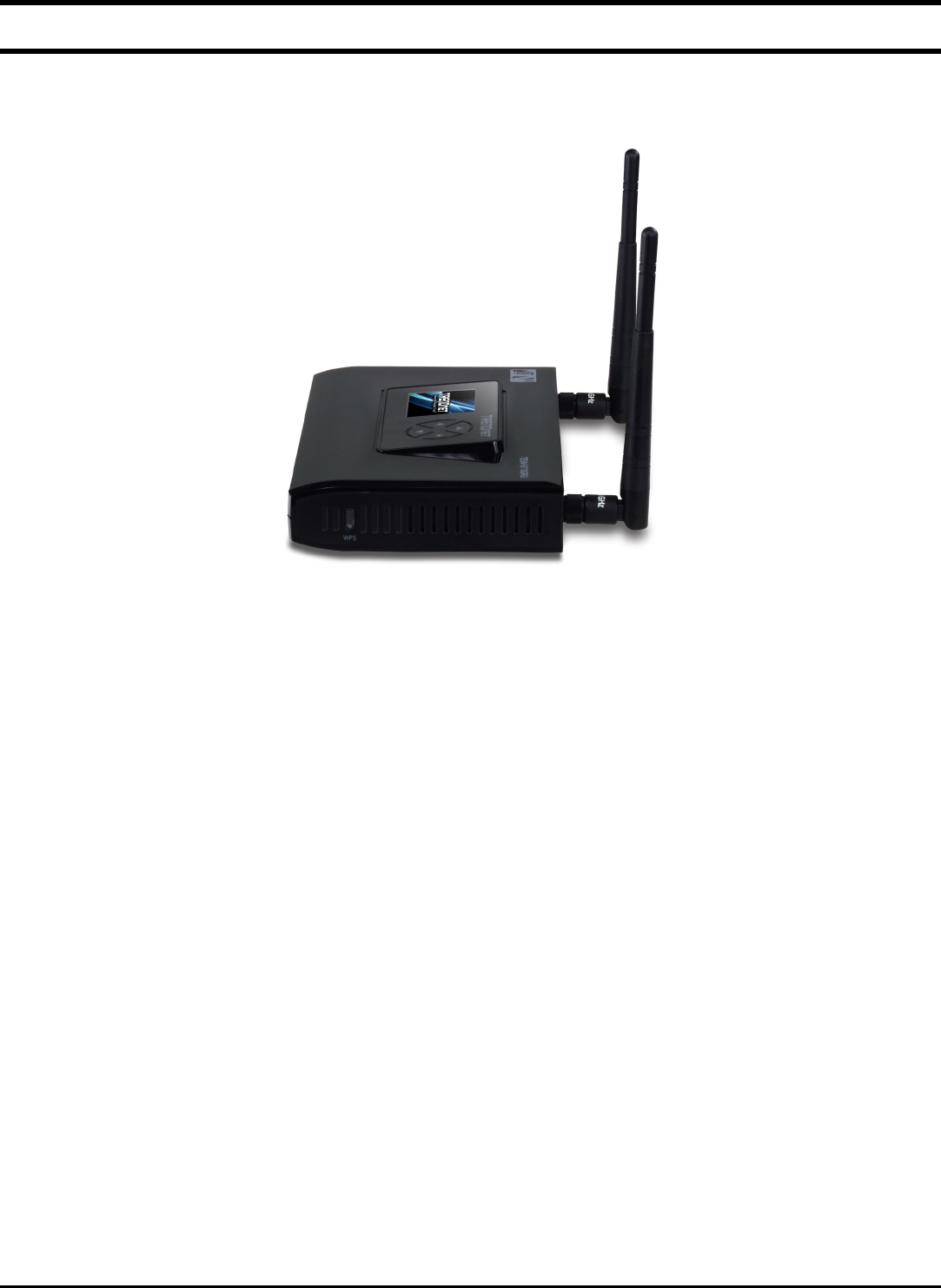
8
Side Panel
The figure below shows the side panel of the 300Mbps Wireless N Dual Band
Gigabit Router with USB Port.
WPS (side panel):
Push this button to execute the Wi-Fi Protected Setup process.
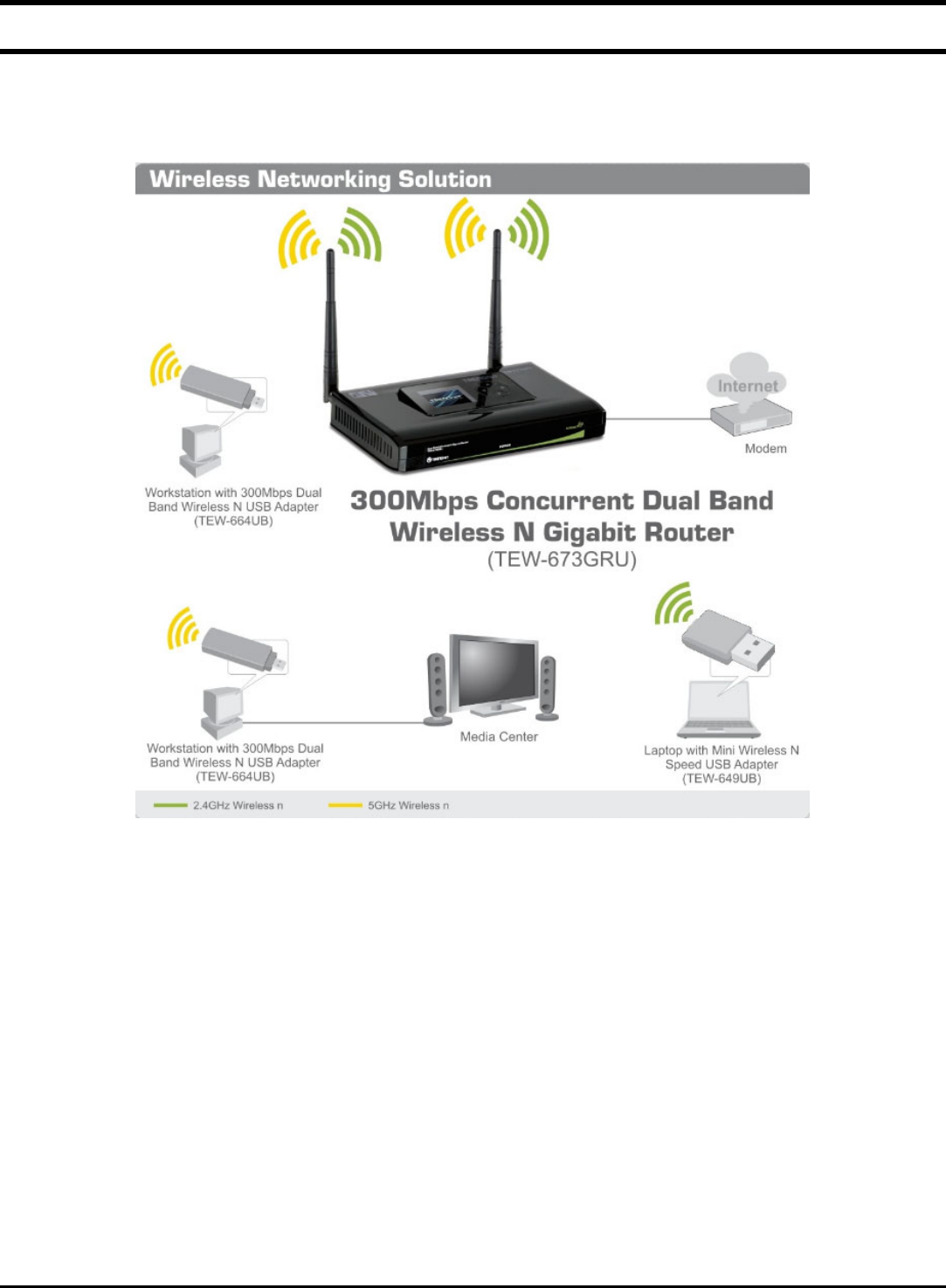
9
Hardware connections
Connecting the WLAN Router
1. Plug in one end of the network cable to the WAN port of the WLAN Router.
2. Plug in the other end of the network cable to the Ethernet port of the xDSL or
Cable modem.
3. Use another network cable to connect to the Ethernet card on the computer
system; the other end of the cable connects to the LAN port of the WLAN
Router. Since the IEEE 300Mbps Wireless N Dual Band Gigabit Router with
USB Port has four ports, you can connect up to four computers directly to the
unit. Then you do not have to buy a switch to connect these computers since one
WLAN Router functions both as a connection-sharing unit and as a switch.
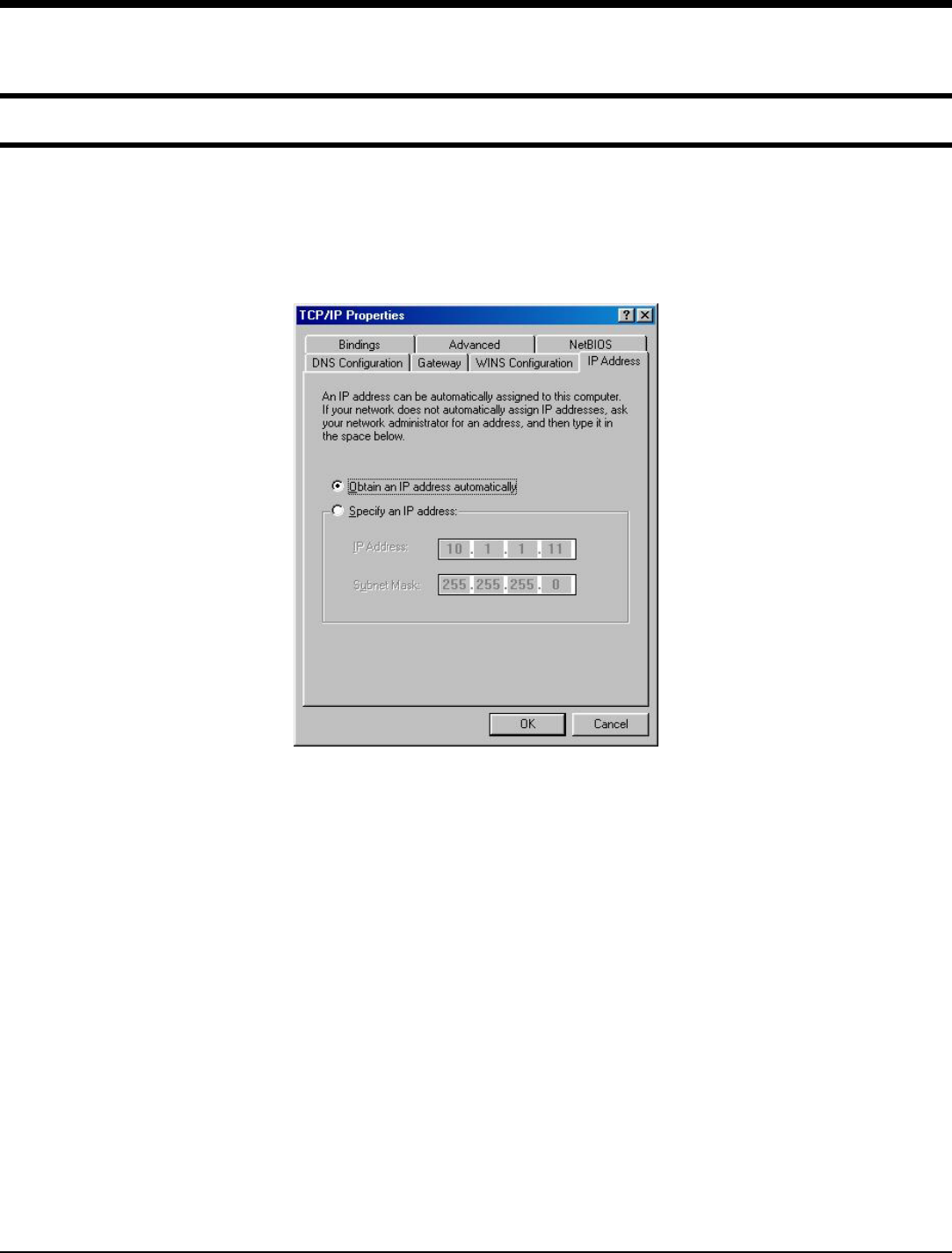
10
PC NETWORK TCP/IP SETTING
The network TCP/IP settings differ based on the computer’s operating system
(Win95/98/ME/NT/2000/XP) and are as follows.
Windows 95/98/ME
1. Click on the “Network neighborhood” icon found on the desktop.
2. Click the right mouse button and a context menu will be show.
3. Select “Properties” to enter the TCP/IP setting screen.
4. Select “Obtain an IP address automatically” on the “IP address” field.
5. Select “Disable DNS” in the “DNS” field.
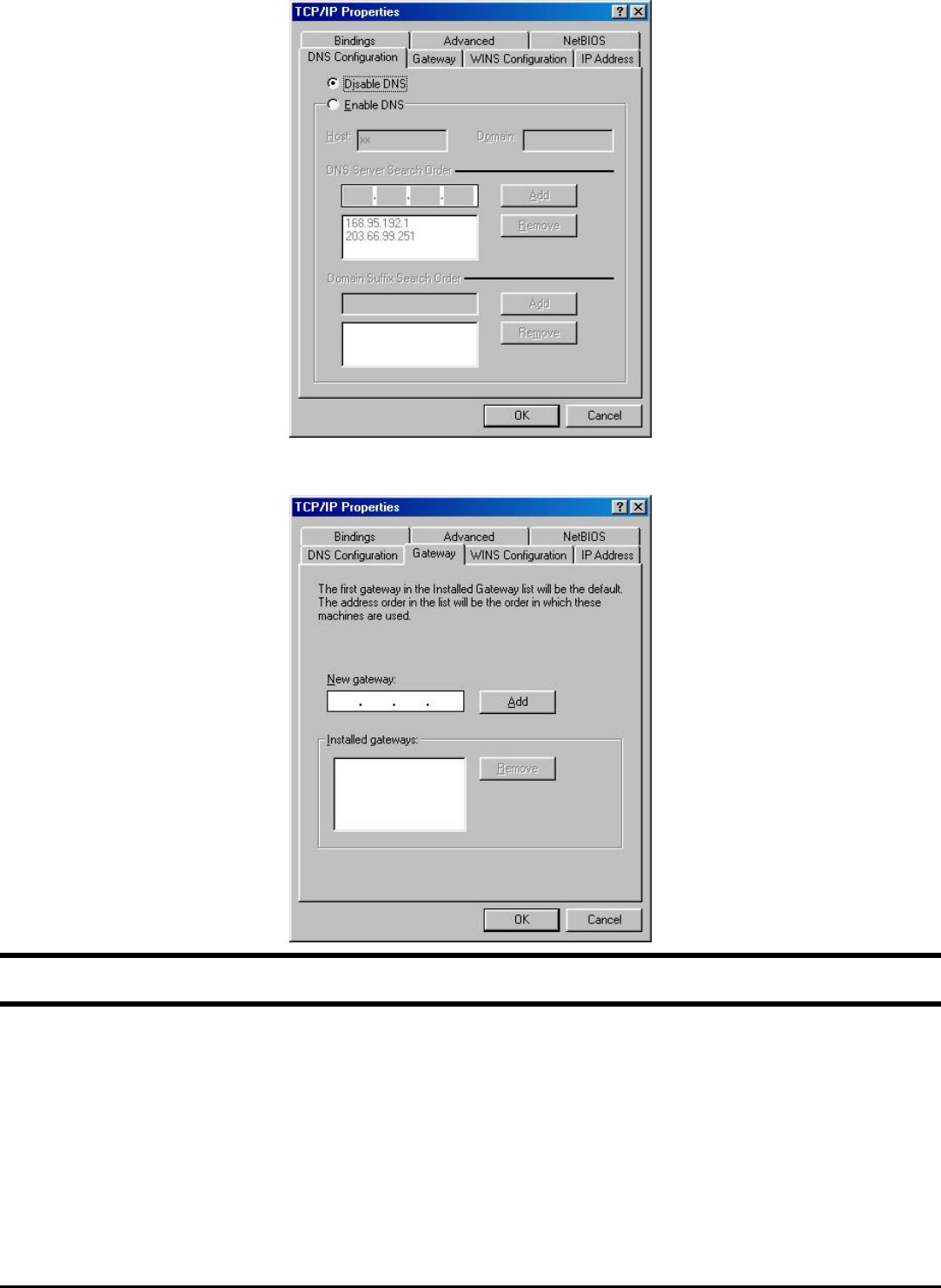
11
6. Select “None” for the “Gateway address” field.
Windows 2000
Double click on the “My Computer” icon on the desktop. When “My Computer”
window opens, open the “Control Panel” and then open the “Network dialup
connection” applet. Double click on the “Local area network connection” icon.
Select “Properties” to enter the TCP/IP setting window.
1. In the “Local area network status” window, click on “Properties.”
2. In the “Local area network connection” window, first select TCP/IP setting
and then select “Properties.”
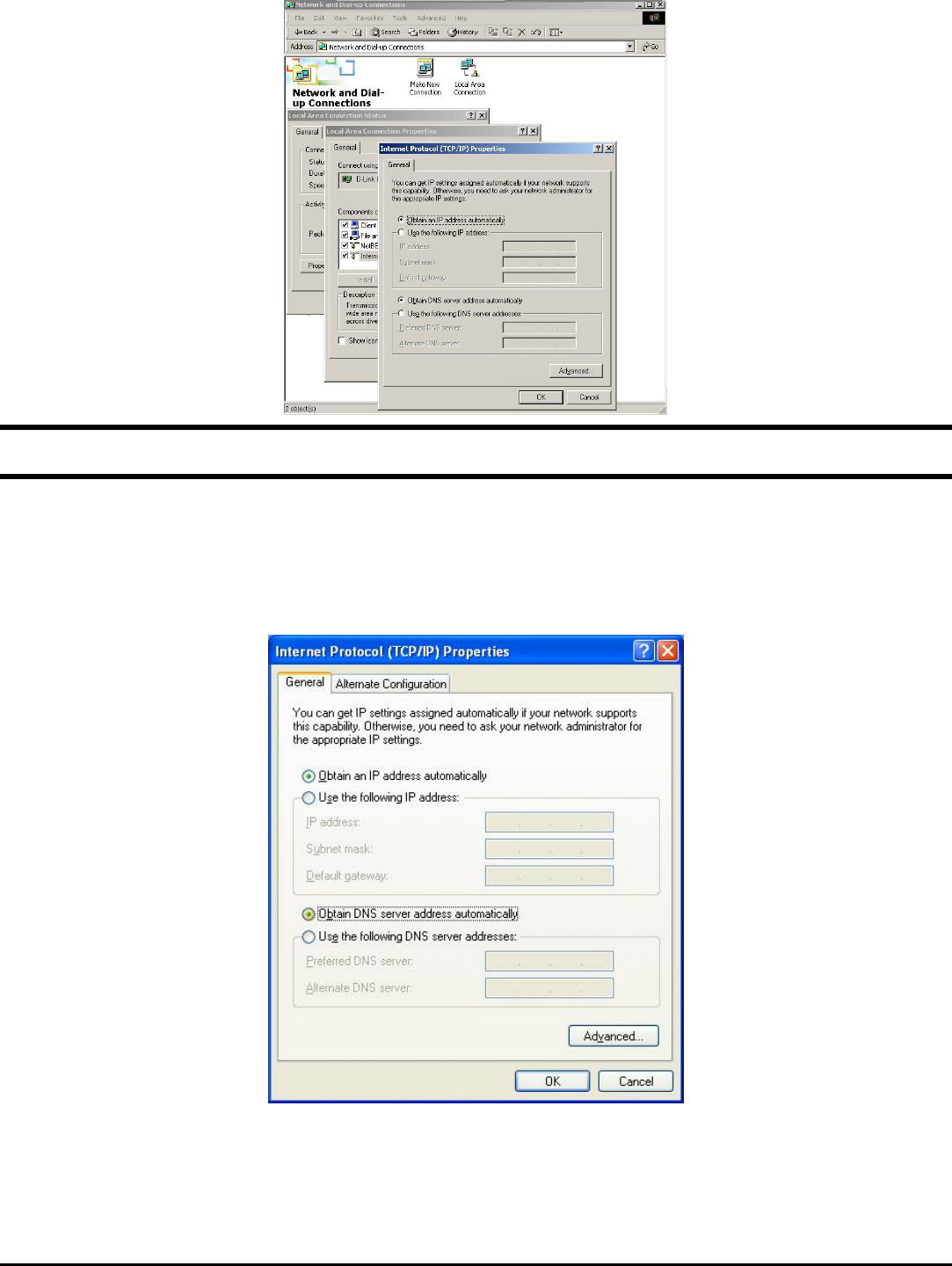
12
3. Set both “IP address” and “DNS” to Automatic configuration.
Windows XP / Vista
Point the cursor and click the right button on the “My Network Place” icon.
Select “properties” to enter the TCP/IP setting window.
1. Set “IP address” to “Obtain an IP address automatically.”
2. Set “DNS” to “Obtain DNS server address automatically.”
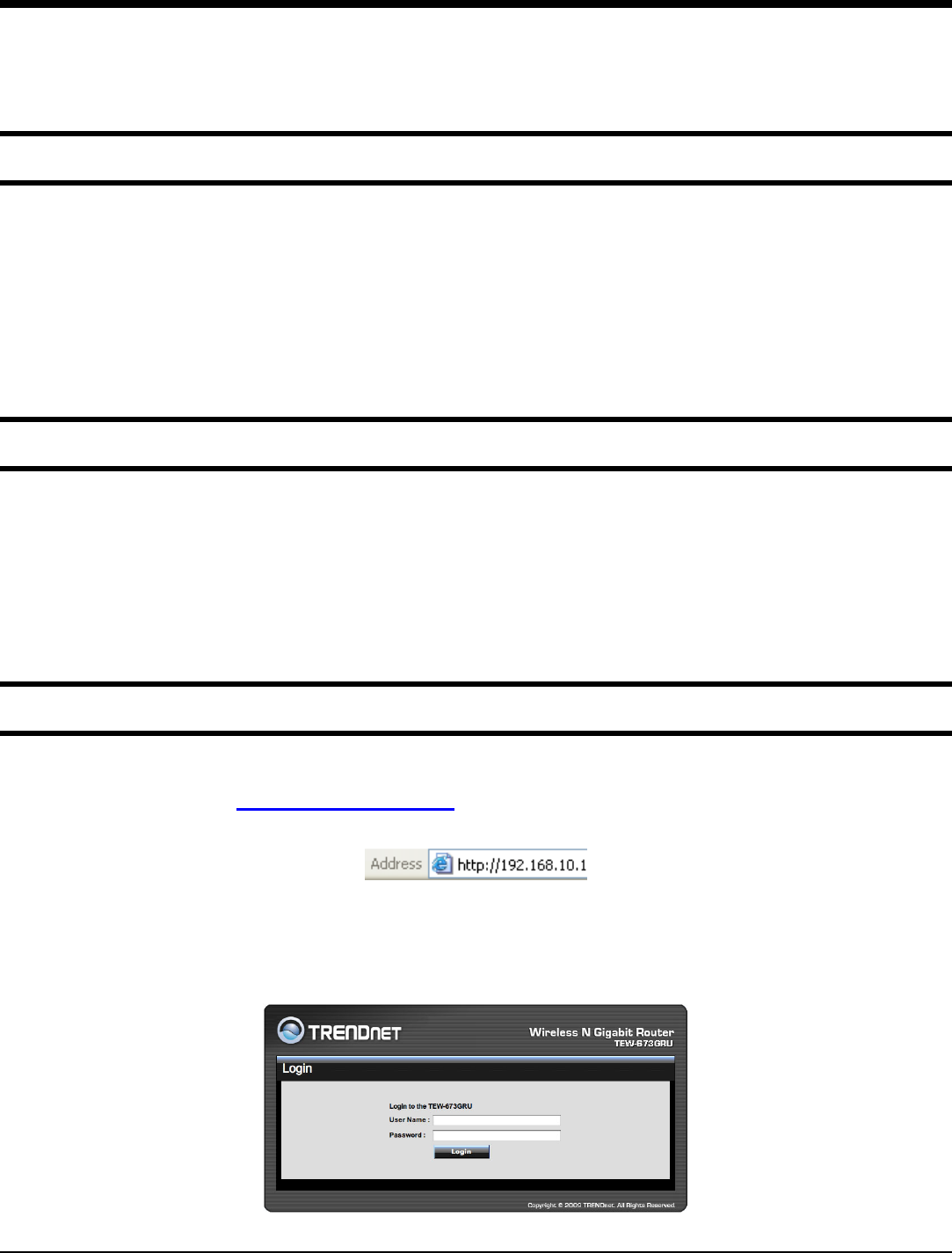
13
CONFIGURATION
First make sure that the network connections are functioning normally.
This WLAN Router can be configured using Internet Explorer 6.0 or newer web
browser versions.
Login to the WLAN Router through Wireless LAN
Before configuring the WLAN Router through WLAN, make sure that the SSID,
Channel and the WEP is set properly.
The default setting of the WLAN Router that you will use:
9 SSID: TRENDnet673N (2.4G band) and TRENDnet673A (5G band)
9 Channel: 6 (2.4G band) and 40 (5G band)
9 Security: disable
Login to the WLAN Router
Before you configure this device, note that when the WLAN Router, make sure the
host PC must be set on the IP subnet that can be accessed by the xDSL/Cable
modem. For example, when the default network address of the xDSL/Cable modem
Ethernet interface is 192.168.10.1, then the host PC should be set at 192.168.10.xxx
(where xxx is a number between 2 and 254), and the default subnet mask is
255.255.255.0.
Using the Web Browser
1. Open Internet Explorer 6.0 or above Internet browser.
2. Enter IP address http://192.168.10.1 (the factory-default IP address setting) to
the URL web address location.
3. When the following dialog box appears, enter the user name and password to
login to the main configuration window, the default username and password is
“admin”.
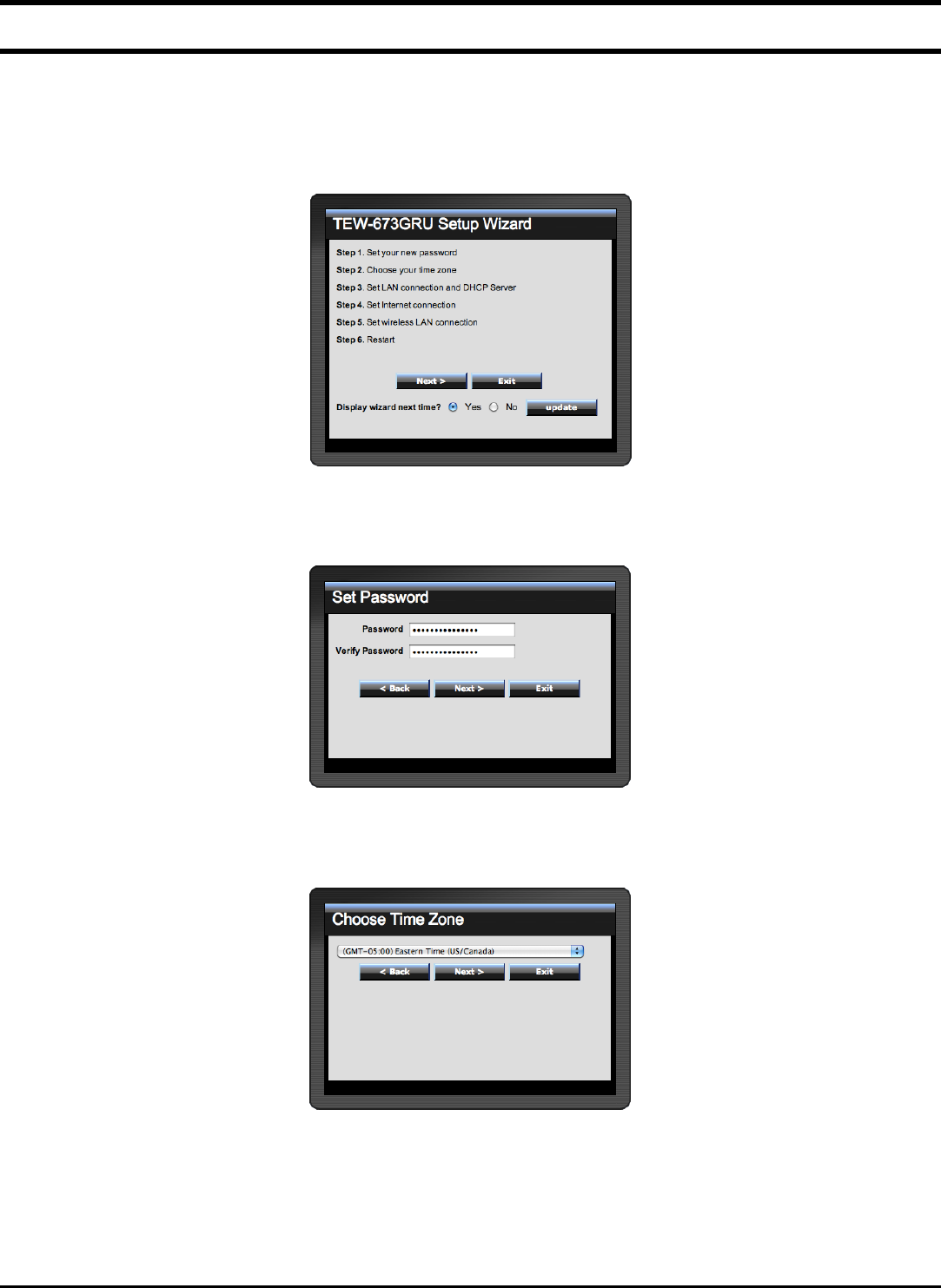
14
Setup Wizard
Setup wizard is provided as part of the web configuration utility. Users can simply
follow the step-by-step process to get the wireless Router configuration ready to run
in 6 easy steps by clicking on` the “Wizard” button on the function menu. The
following screen will appear. Please click “Next” to continue.
Step 1: Set your new password
Set a new admin password of the WLAN Router. Please click “Next” to continue.
Step 2: Choose time zone
Select the time zone from the drop down list. Please click “Next” to continue.
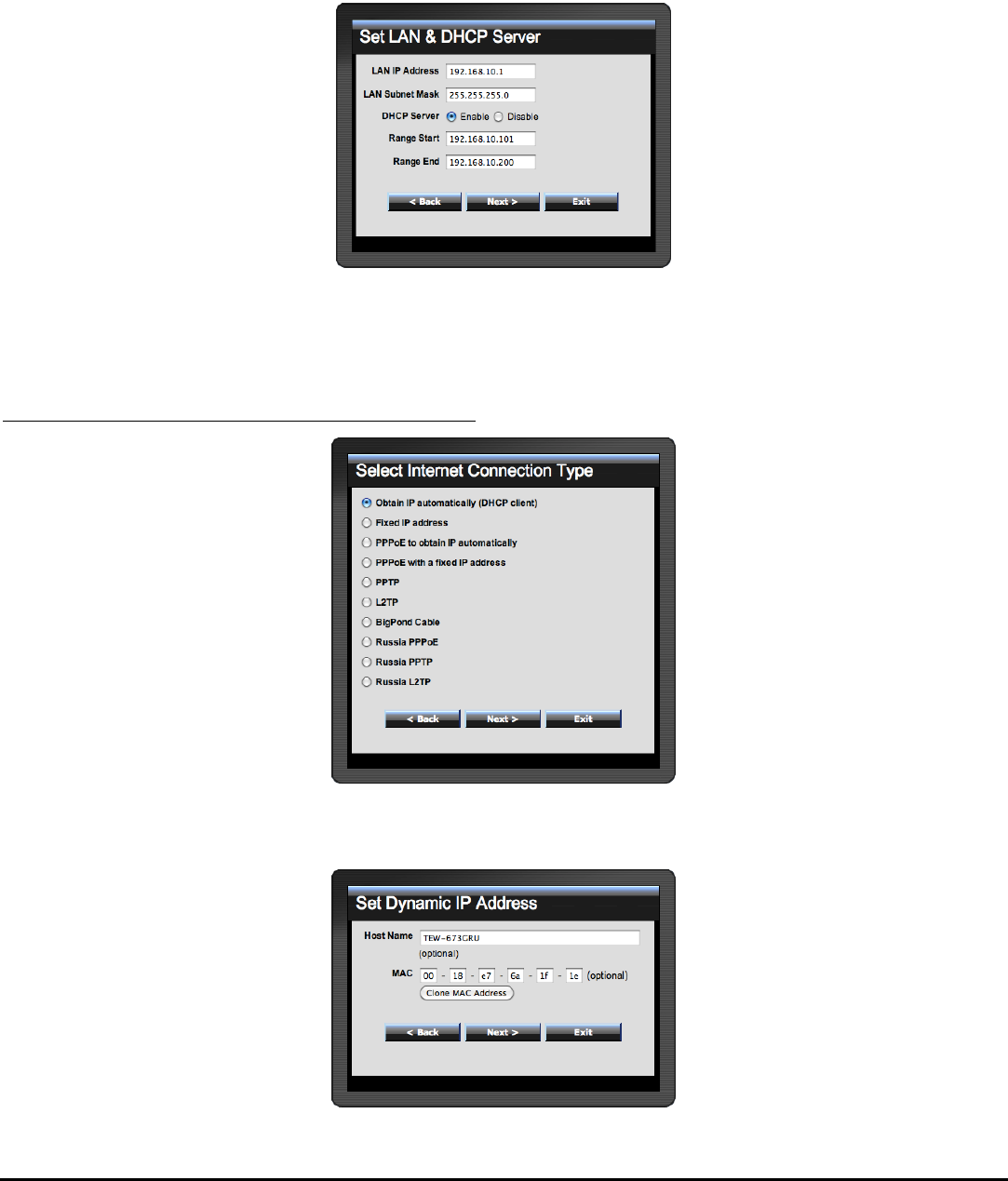
15
Step 3: Set LAN connection and DHCP server
Set user’s IP address and mask. The default IP is 192.168.10.1. If the user chooses
to enable DHCP, please click “Enable”. DHCP enabled is able to automatically
assign IP addresses. Please assign the range of IP addresses in the fields of “Range
start” and “Range end”. Please click “Next” to continue.
Step 4: Set Internet connection
The WLAN Router will attempt to auto detect your Internet Connection.
Obtain IP automatically (DHCP client):
If the user has enabled DHCP server, choose "Obtain IP automatically (DHCP
client)" to have the WLAN Router assign IP addresses automatically.
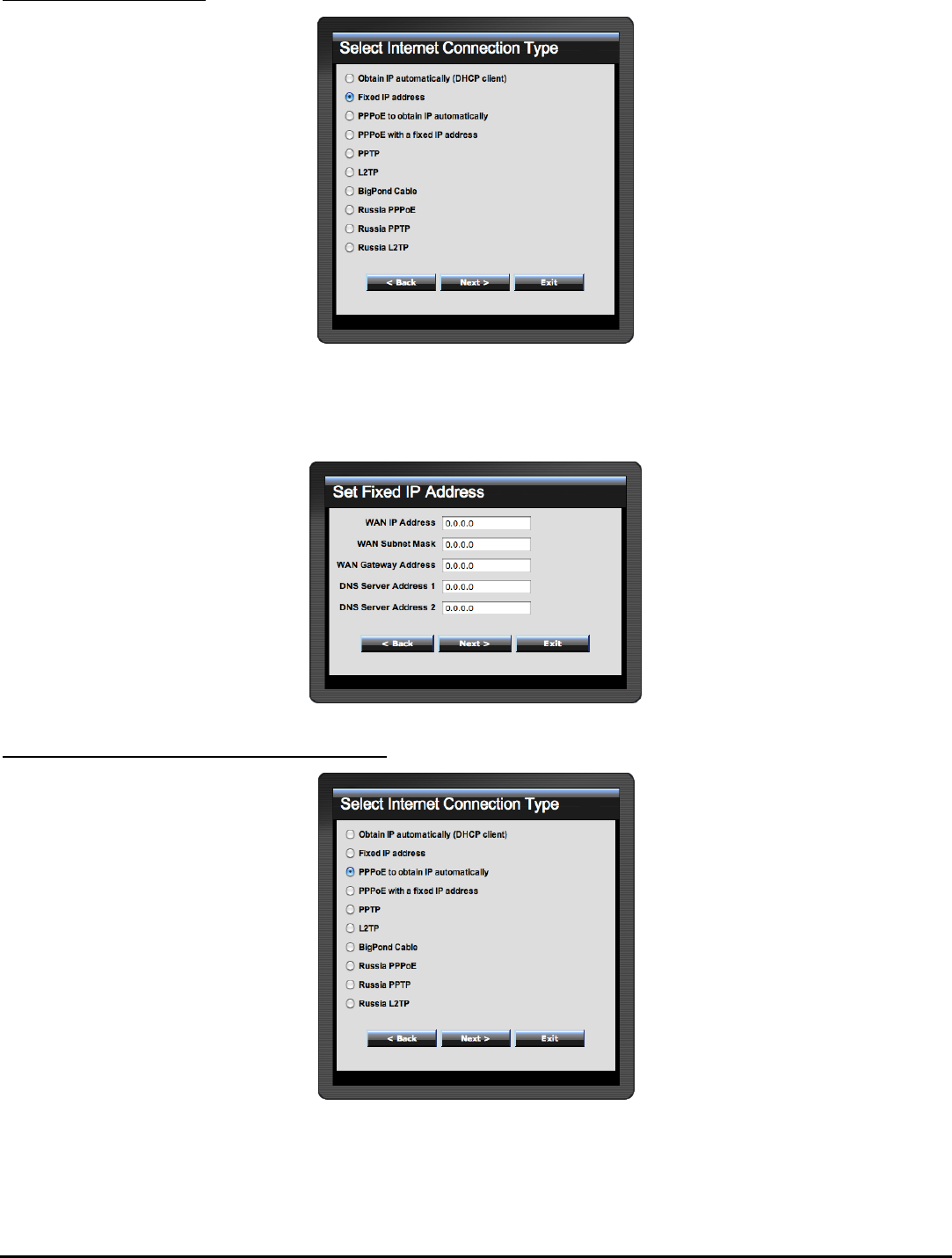
16
Fixed IP Address:
If the Internet Service Provider (ISP) assigns a fixed IP address, choose this option
and enter the assigned WAN IP Address, WAN Subnet Mask, WAN Gateway
Address and DNS Server Addresses for the WLAN Router.
PPPoE to obtain IP automatically:
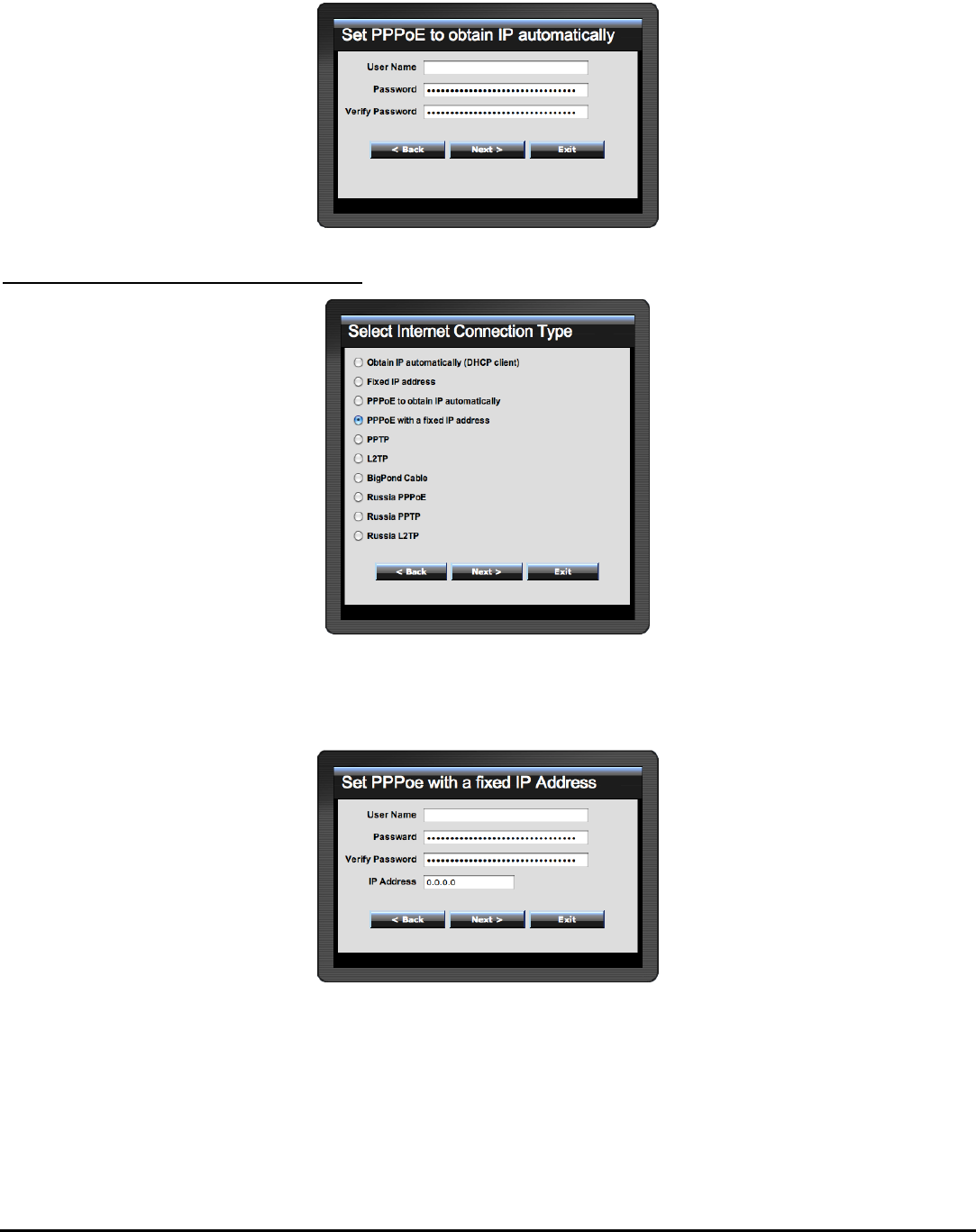
17
If connected to the Internet using a PPPoE (Dial-up xDSL) connection, and the ISP
provides a User Name and Password, then choose this option and enter the required
information.
PPPoE with a fixed IP address:
If connected to the Internet using a PPPoE (Dial-up xDSL) connection, and the ISP
provides a User Name, Password and a Fixed IP Address, choose this option and
enter the required information.
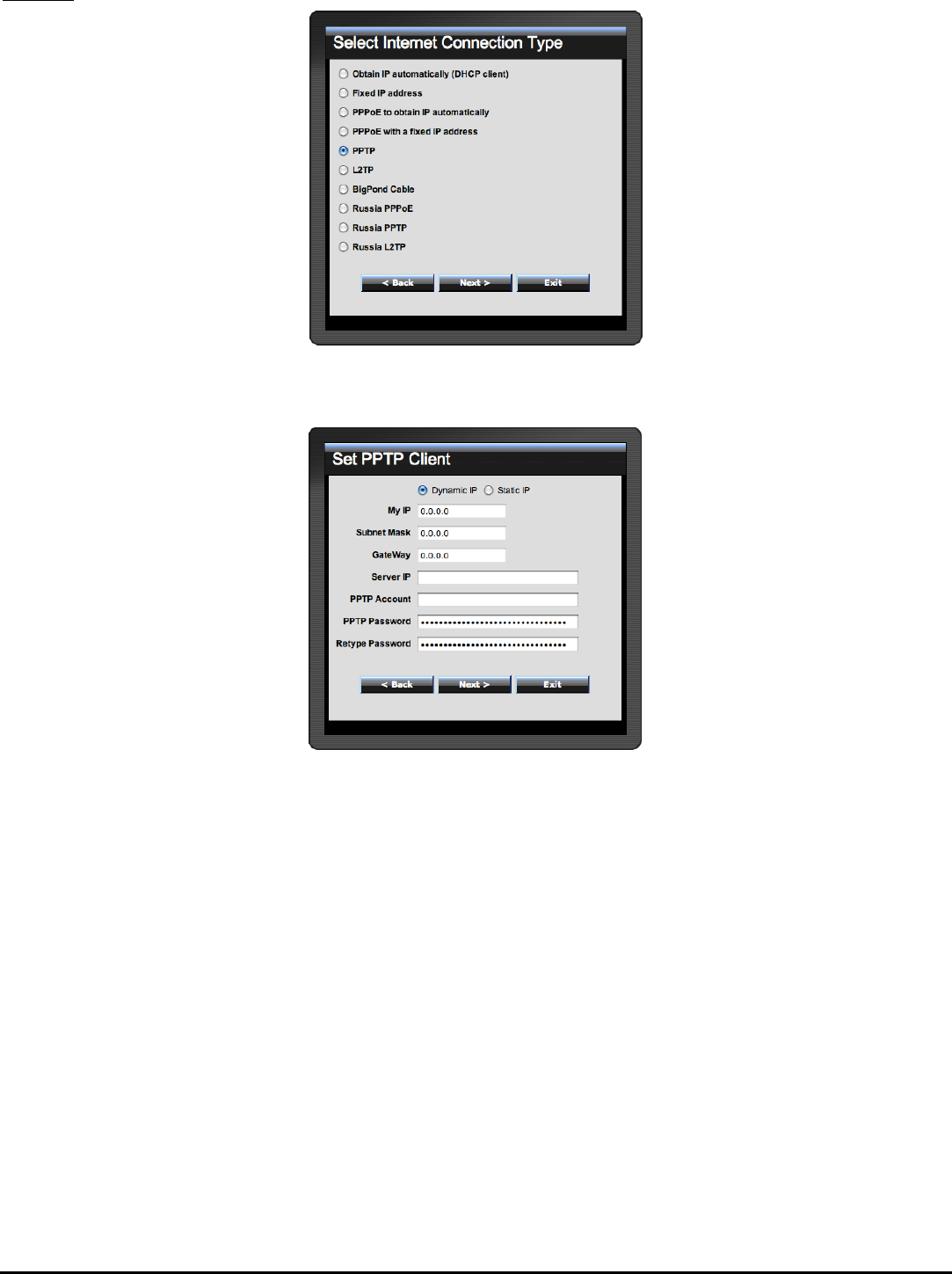
18
PPTP:
If connected to the Internet using a PPTP xDSL connection, enter your IP, Subnet
Mask, Gateway, Server IP, PPTP Account and PPTP Password.
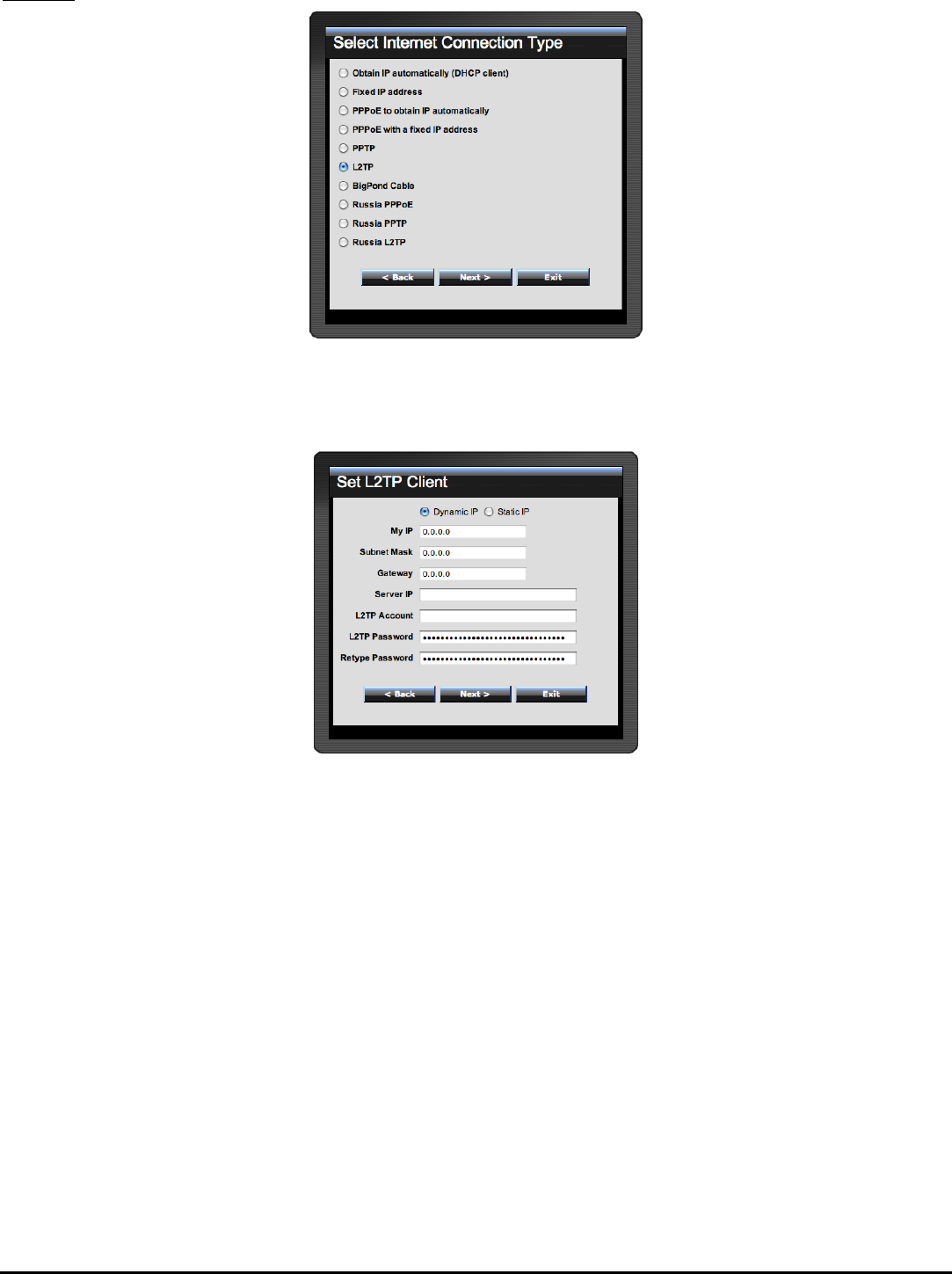
19
L2TP:
If connected to the Internet using a L2TP (Dial-up xDSL) connection and the ISP
provides a Server IP, Account and Password information, choose this option and
enter the required information.
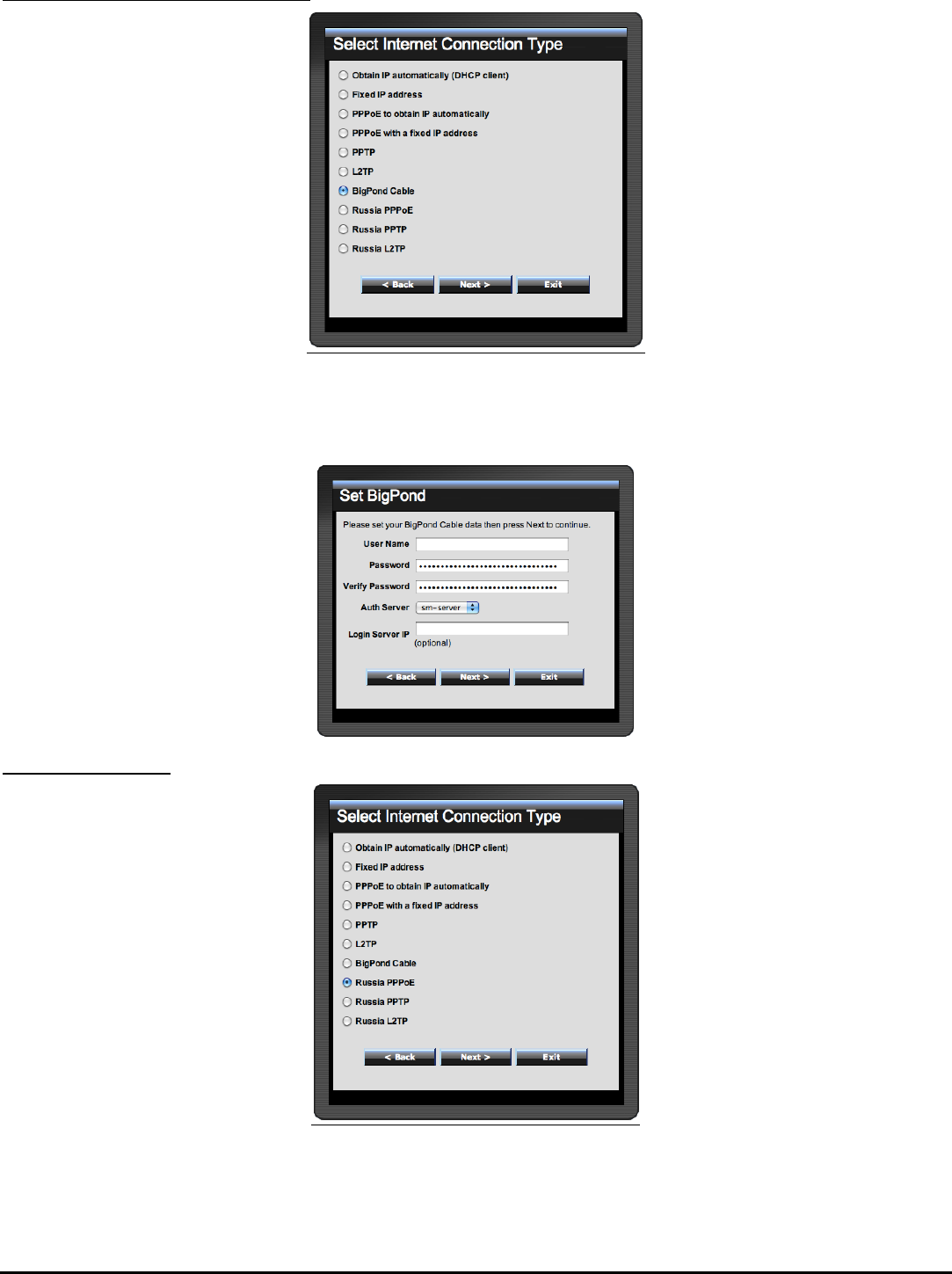
20
Big Pond Cable(Australia):
If your ISP is Big Pond Cable, the ISP will provide a User Name, Password,
Authentication Server and Login Server IP (Optional). Choose this option and
enter the required information.
Russia PPPoE:
If your ISP is Russian PPPoE, the ISP will provide a User Name, Password. If you
have a Static IP WAN Physical IP Address, WAN Physical Subnet Mask and WAN
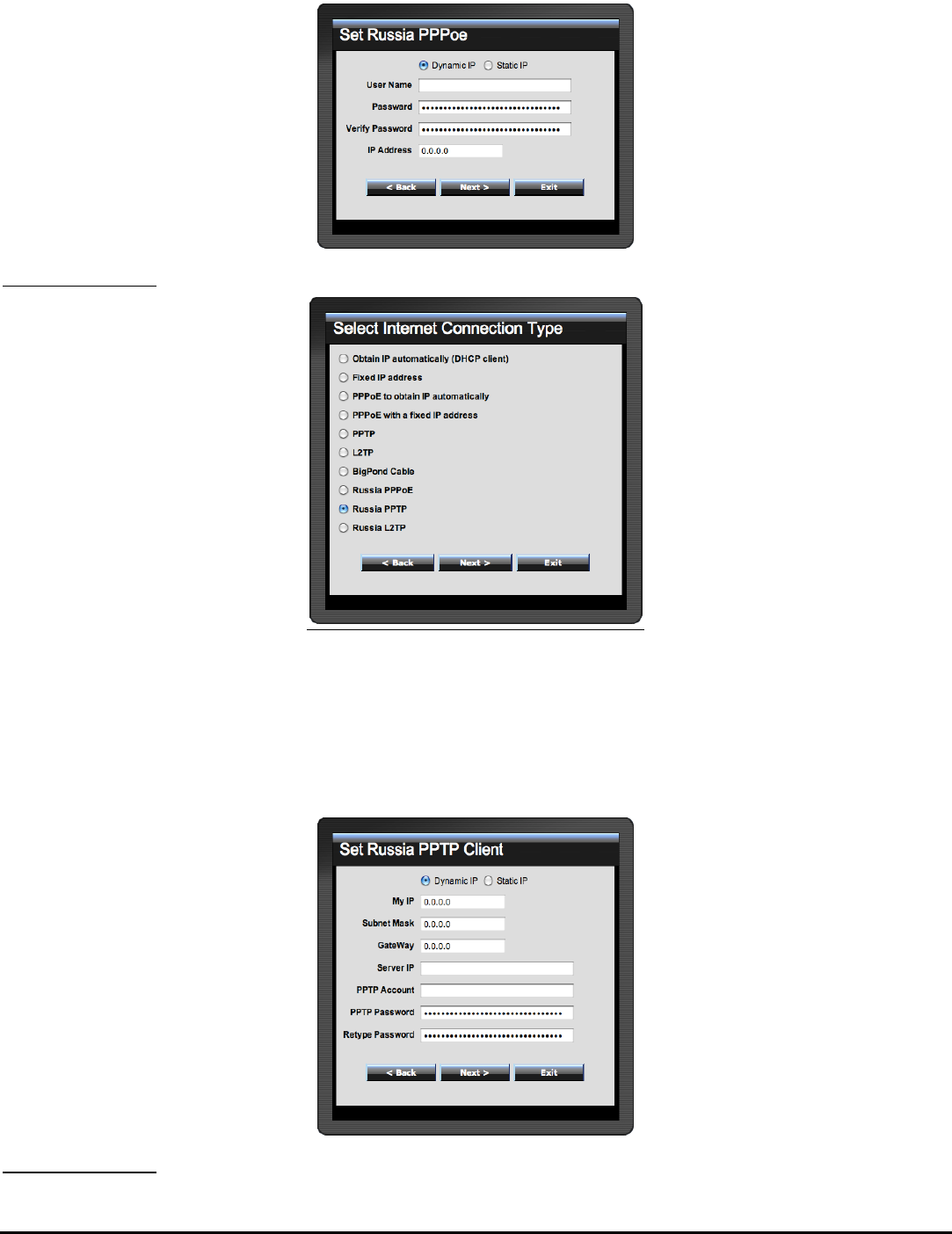
21
Physical Gateway IP Address will be required. Choose this option and enter the
required information.
Russia PPTP:
If connected to the Internet using Russian PPTP xDSL connection, enter your
server IP, PPTP Account and Password. If using Static IP you must enter your IP,
Subnet Mask, Gateway, Server IP, PPTP Account and PPTP Password.
Russia L2TP:
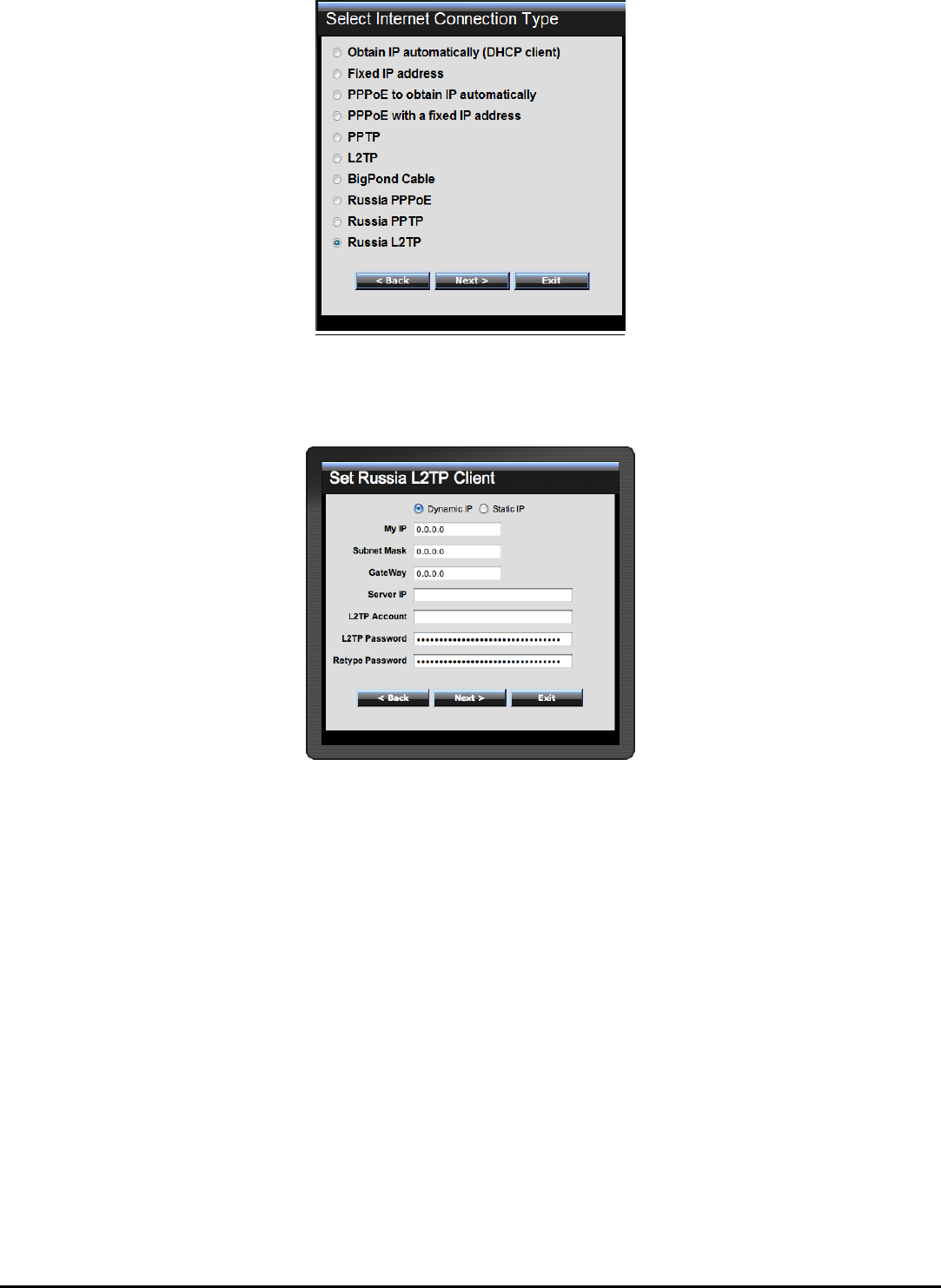
22
If connected to the Internet using Russian L2TP (Dial-up xDSL) enter your server
IP, PPTP Account and Password. If using Static IP you must enter your IP, Subnet
Mask, Gateway, Server IP, PPTP Account and PPTP Password.
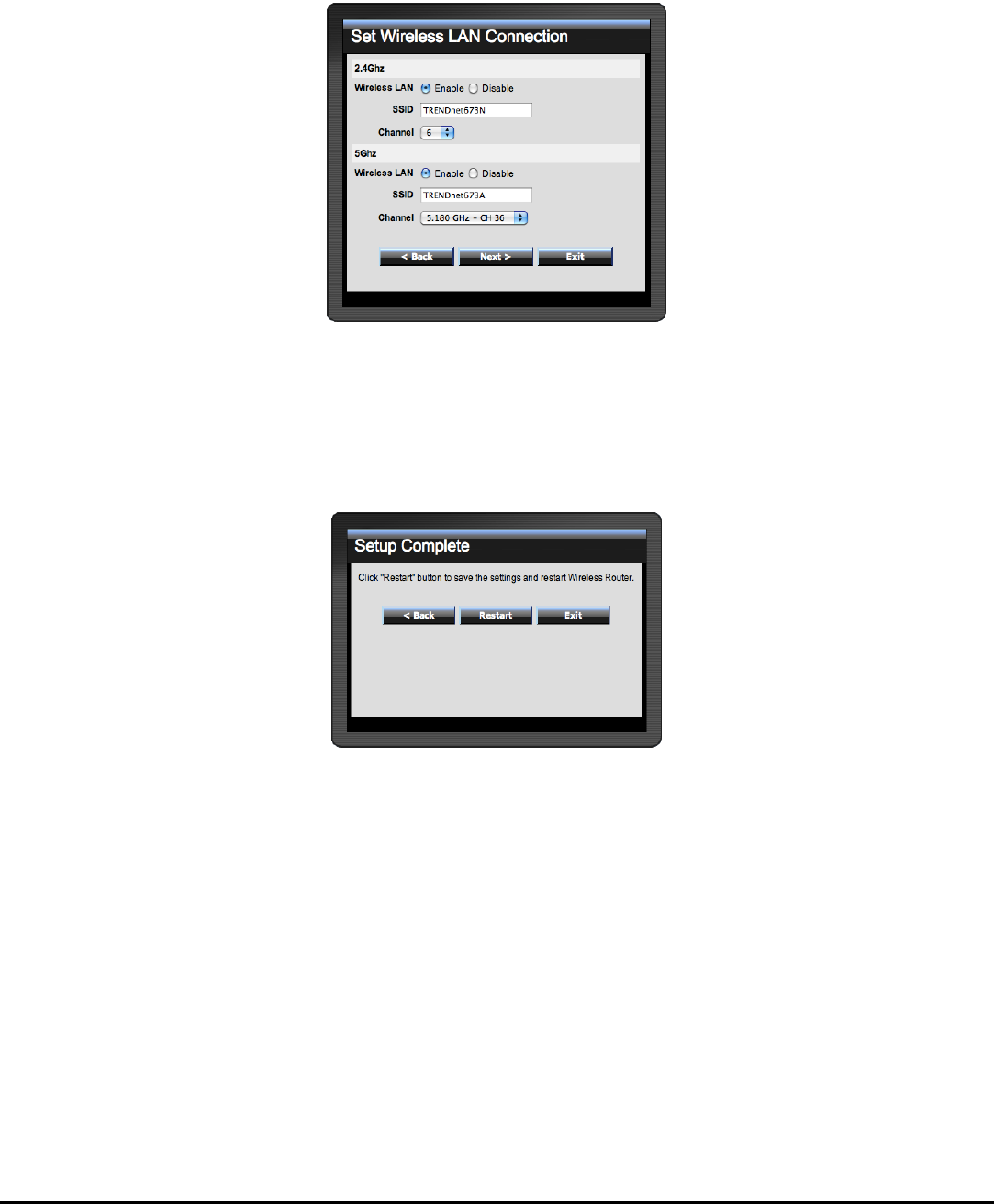
23
Step 5: Set Wireless LAN connection
Click “Enable” to enable Wireless LAN. If user enables the Wireless LAN, type the
SSID in the text box and select a channel. The SSID and channel must be the same
as wireless devices attempting to connect to the WLAN Router.
Step 6: Setup completed
The Setup wizard is now completed. The new settings will be effective after the
WLAN Router restarts. Please click “Restart” to reboot the WLAN Router. If user
does not want to make any changes, please click “Exit” to quit without any changes.
User also can go back to modify the settings by clicking “Back”.
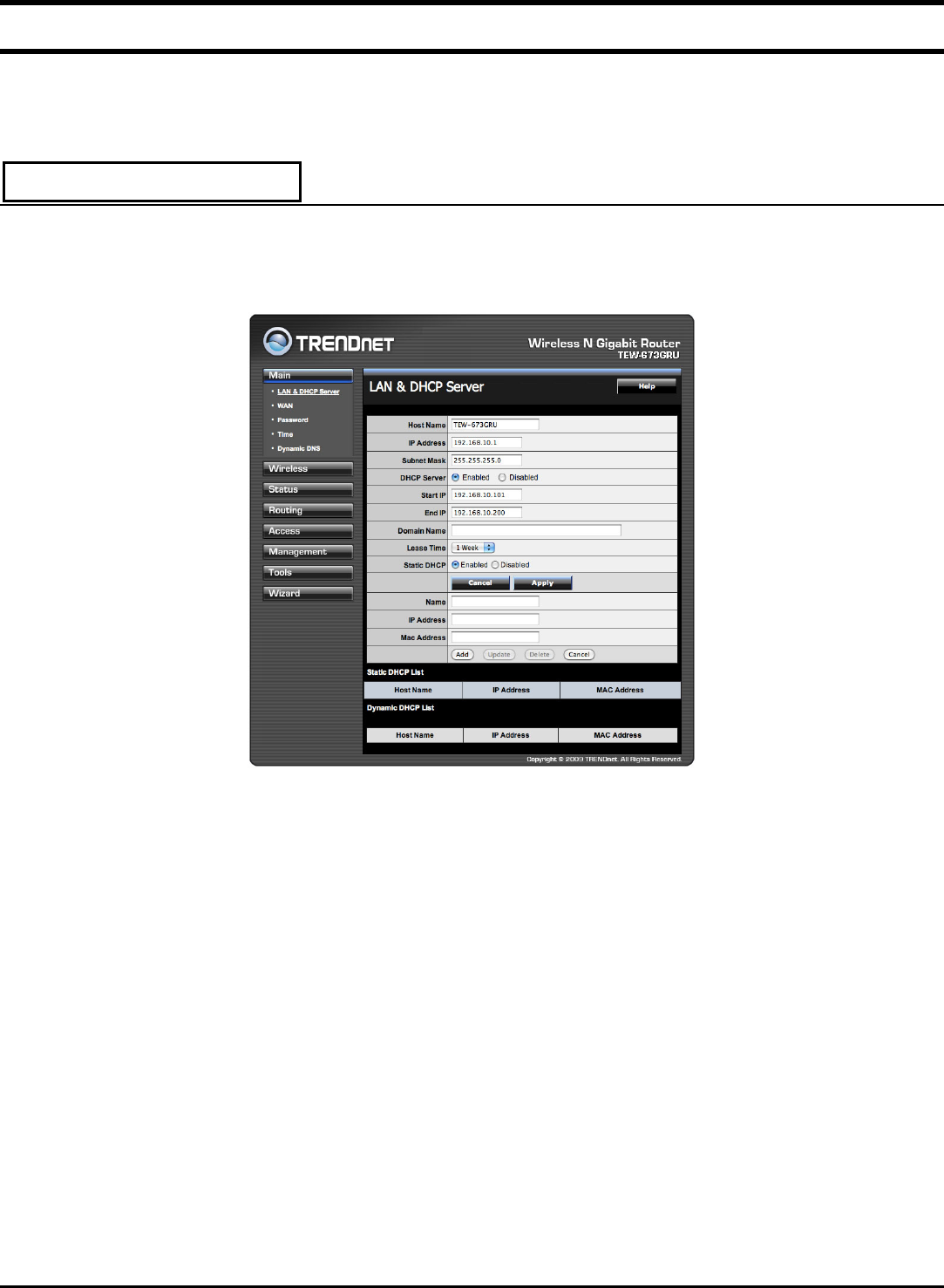
24
Main configuration
The screen enables users to configure the LAN & DHCP Server, set WAN
parameters, create Administrator and User passwords, and set the local time, time
zone, and dynamic DNS.
LAN & DHCP Server
This page allows the user to configure LAN and DHCP properties, such as the host
name, IP address, subnet mask, and domain name. LAN and DHCP profiles are
listed in the DHCP table at the bottom of the screen.
Host Name: Type the host name in the text box. The host name is required by
some ISPs. The default host name is "TEW-673GRU"
IP Address: This is the IP address of the WLAN Router. The default IP address is
192.168.10.1.
Subnet Mask: Type the subnet mask for the WLAN Router in the text box. The
default subnet mask is 255.255.255.0.
DHCP Server: Enables the DHCP server to allow the WLAN Router to
automatically assign IP addresses to devices connecting to the LAN port or
wirelessly. DHCP is enabled by default.
All DHCP client computers are listed in the table at the bottom of the screen,
providing the host name, IP address, and MAC address of the client.
Start IP: Type an IP address to serve as the start of the IP range that DHCP server
will use to assign IP addresses to all LAN devices connected to the WLAN Router.
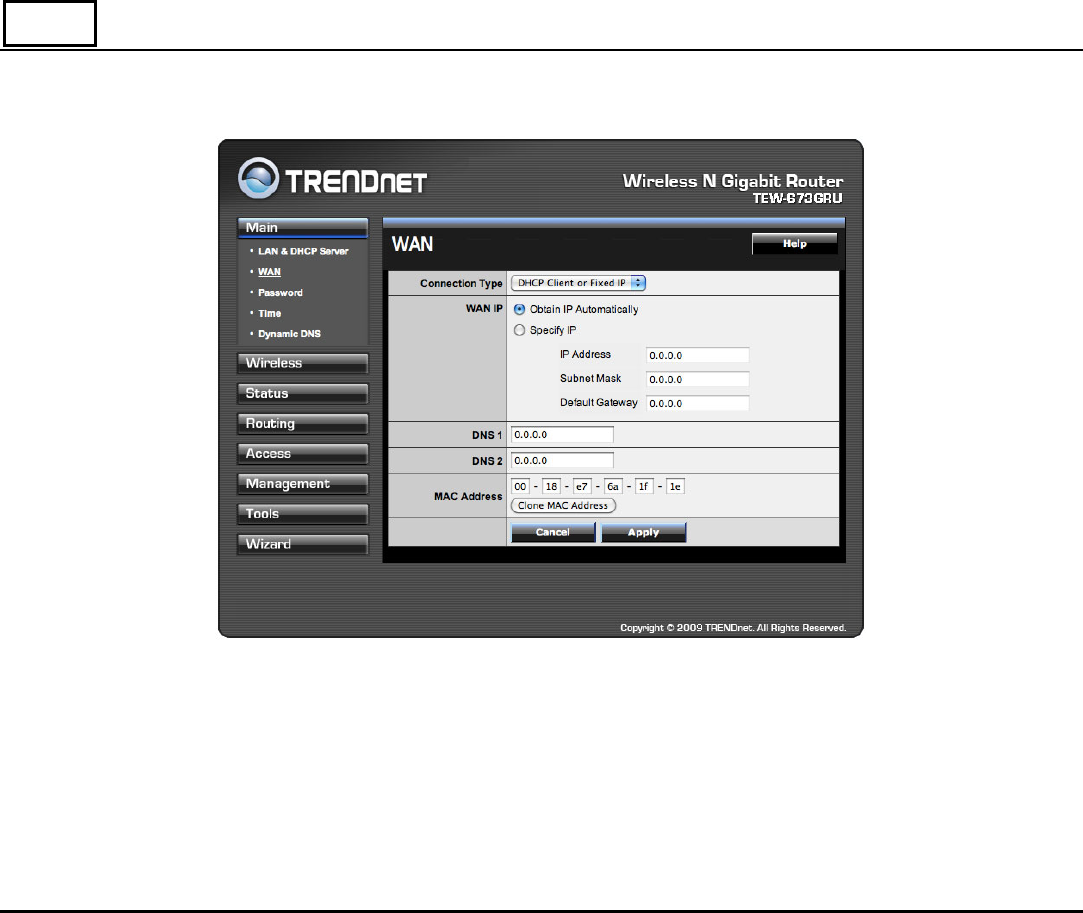
25
End IP: Type an IP address to serve as the end of the IP range that DHCP will use
to assign IP addresses to all LAN devices connected to the WLAN Router.
Domain Name: Type the local domain name of the network in the text box. This
item is optional.
Lease Time: The lease time specifies the amount of connection time a network
user be allowed with their current dynamic IP address.
Static DHCP: This option enables users to statically assign IP address to LAN
clients connected to the WLAN router.
Name: Type the name of the LAN client that will be using the static IP address.
IP Address: Type an IP address to assign a LAN client.
MAC Address: Enter the MAC address of the specific LAN client that will be
using the IP address.
Static DHCP List: List all static IP address assigned on the WLAN router.
Dynamic DHCP List: List all assigned DHCP clients on the WLAN router.
WAN
This screen enables users to set up the WLAN Router’s WAN connection, specify
the IP address for the WAN, add DNS numbers, and enter the MAC address.
Connection Type: Select the connection type, DHCP client or Fixed IP, PPPoE,
PPTP, L2TP, BigPond Cable, Russia PPPoE, Russia, PPTP and Russia L2TP from
the drop-down list.
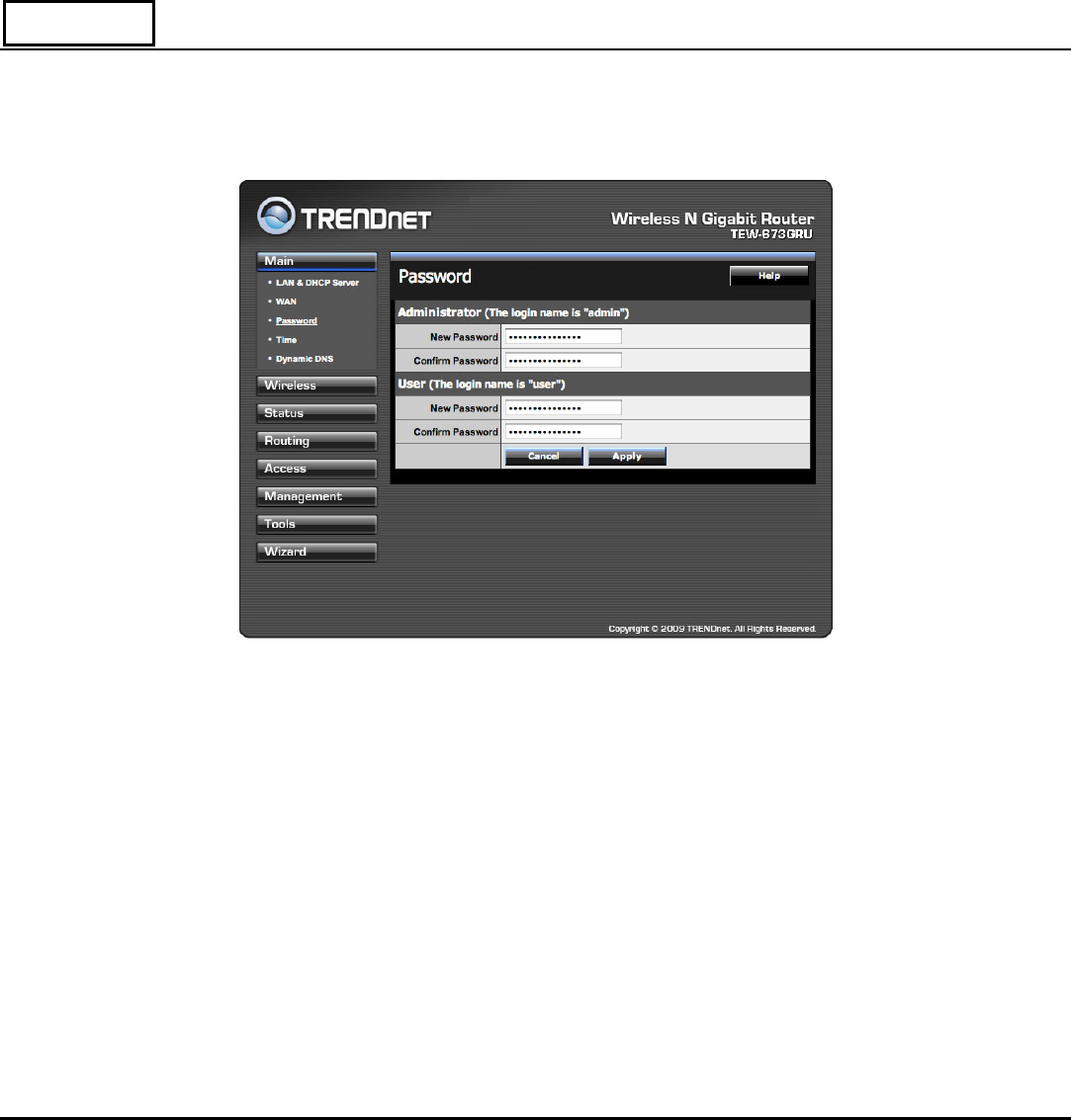
26
WAN IP: Select whether user wants to specify an IP address manually, or want to
obtain an IP address automatically. When Specify IP is selected, type the IP address,
subnet mask, and default gateway in the text boxes. User’s ISP will provide with
this information.
DNS 1-2: Type up to 2 DNS numbers in the text boxes. User’s ISP will provide this
information.
MAC Address: If required by user’s ISP, type the MAC address of the WLAN
Router WAN interface in this field. Or click on CLONE MAC Address to
automatically enter your PC’s MAC address.
Password
This screen enables users to set administrative and user passwords. These
passwords are used to gain access to the WLAN Router interface.
Administrator: Type the password the Administrator will use to log into the
system. The password must be typed again for confirmation. The Administrator
have the ability to apply and setting on the WLAN Router.
User: Type the password the User will use to log in to the system. The password
must be typed again for confirmation. The User accounts only have the ability to
view settings and cannot apply any setting changes.
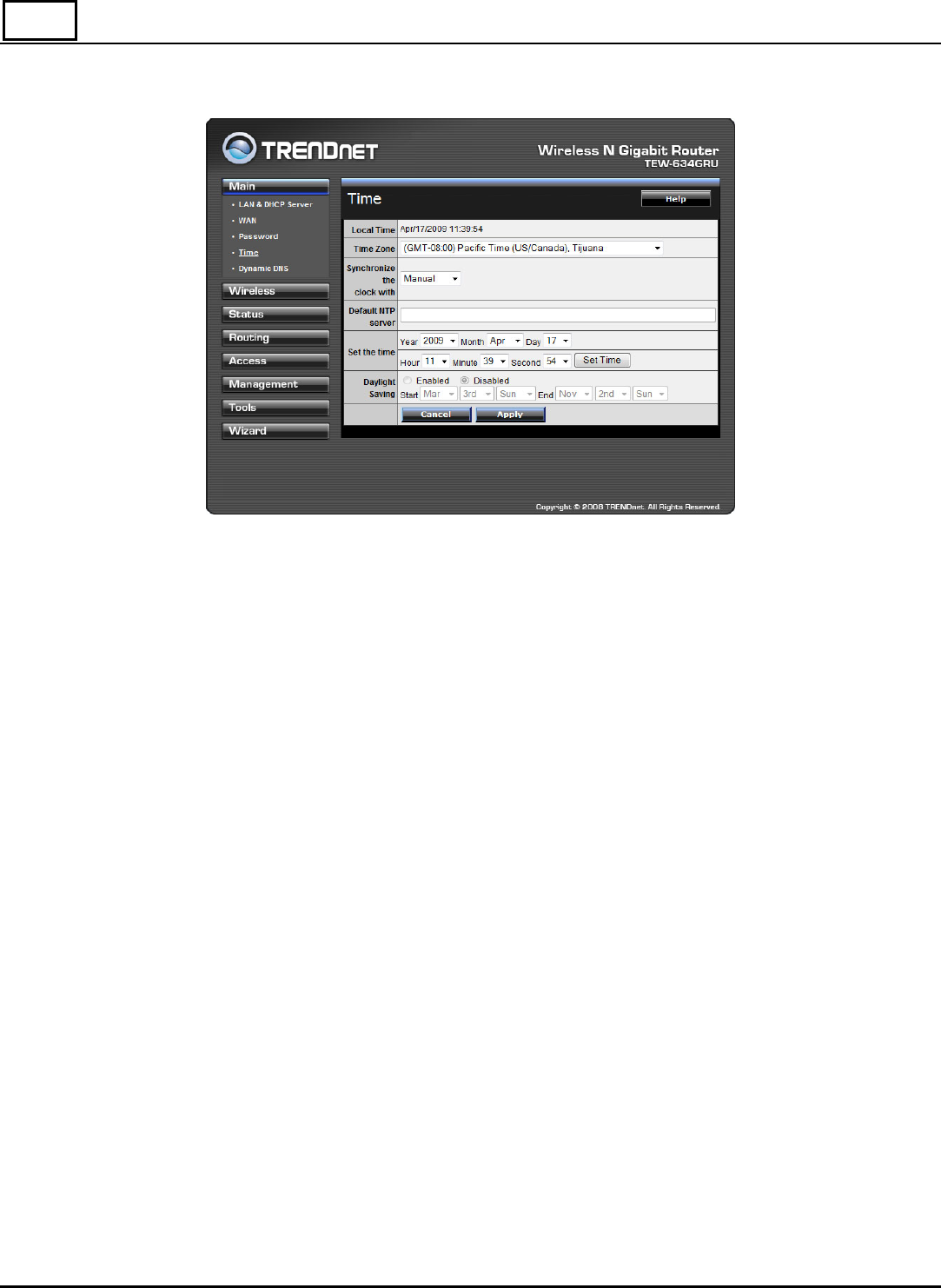
27
Time
This screen enables users to set the time and date for the WLAN Router's real-time
clock, select properly time zone, and enable or disable daylight saving.
Local Time: Displays the current time applied on the WLAN Router.
Time Zone: Select the time zone from the drop-down list.
Synchronize the clock with: Select the clock adjustment method form the drop-
down list.
Automatic: Automatically adjust the system time from an entered NTP Server
Manual: Manually adjust the system time when you press the Set Time button.
Default NTP server: The Simple Network Time Protocol (SNTP) server allows
the WLAN Router to synchronize the system clock to the global Internet through
the SNTP Server. Specify the NTP domain name or IP address in the text box.
Set the time: Manually setting the WLAN Router system time, press the Set Time
button to update the system time.
Daylight Saving: Enables users to enable or disable daylight saving time. When
enabled, select the start and end date for daylight saving time.
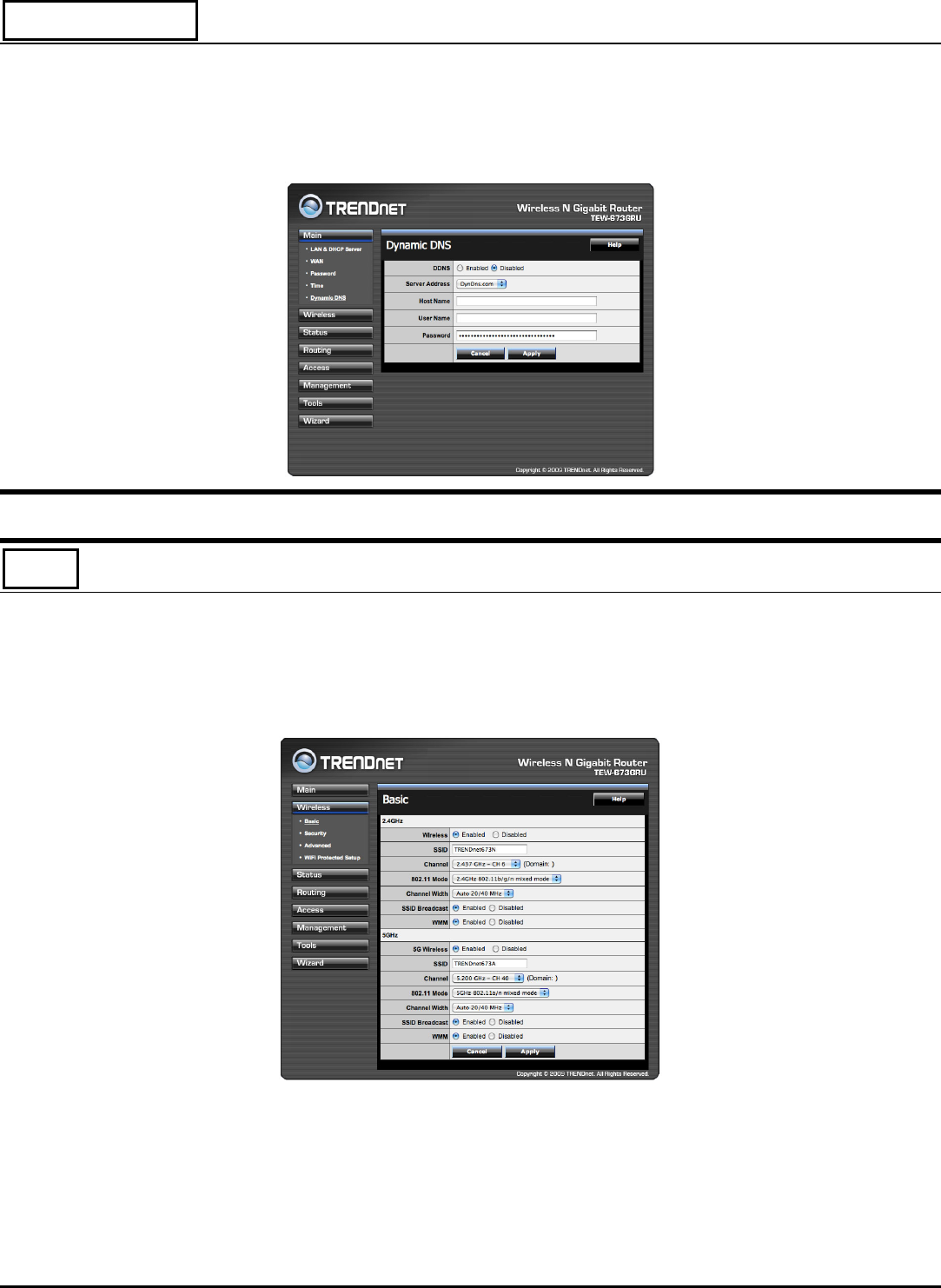
28
Dynamic DNS
This synchronizes the DDNS server with your current Public IP address when you
are online. First, you need to register your preferred DNS with the DDNS provider.
Then, please select the DDNS address in the Server Address and fill the related
information in the below fields: Host Name, User Name and Password.
Wireless
Basic
This section enables users to configure the wireless parameters for the WLAN
Router.
This page allows you to enable and disable the wireless LAN function, create a
SSID, and select the channel for wireless communications.

29
2.4GHz
Enable/Disable: Enables or disables 2.4GHz wireless LAN on the WLAN Router.
SSID: Type an SSID in the text box. The SSID of any wireless device must match
the SSID typed here in order for the wireless device to access the LAN and WAN
of the WLAN Router.
Channel: Select a transmission channel for wireless communications. The channel
of any wireless device must match the channel selected here in order for the
wireless device to access the LAN and WAN via the WLAN Router.
802.11 Mode: Select one of the following:
z 2.4GHz 802.11b/g mixed mode - Select if you are using both 2.4GHz
802.11b and 802.11g wireless clients.
z 2.4GHz 802.11b/g/n mixed mode - Select if you are using a mix of 2.4GHz
802.11b, 11g, and 11n wireless clients.
z 2.4GHz 802.11n only mode - Select if you are using only 2.4GHz 802.11n
wireless clients.
Channel Width: Select the Channel Width:
z Auto 20/40 - Auto select channel bandwidth for 20MHz or 40MHz (depended
on linking quality).
z 20MHz - Force the channel bandwidth for 20MHz.
SSID Broadcast: While SSID Broadcast is enabled, all wireless clients will be able
to view the WLAN Router’s SSID. For security purposes, users may want to
disable SSID Broadcast to ensure only authorized clients have access.
WMM: If selected the Enable, the WMM (Wi-Fi Multimedia Quality of Service)
feature will be enabled.

30
5GHz
Enable/Disable: Enables or disables 5GHz wireless LAN on the WLAN Router.
SSID: Type an SSID in the text box. The SSID of any wireless device must match
the SSID typed here in order for the wireless device to access the LAN and WAN
of the WLAN Router.
Channel: Select a transmission channel for wireless communications. The channel
of any wireless device must match the channel selected here in order for the
wireless device to access the LAN and WAN via the WLAN Router.
802.11 Mode: Select one of the following:
z 5GHz 802.11a/n mixed mode - Select if you are using both 5GHz 802.11a
and 802.11n wireless clients.
z 5GHz 802.11a only mode - Select if you are using only 5GHz 802.11a
wireless clients.
Channel Width: Select the Channel Width:
z Auto 20/40 - Auto select channel bandwidth for 20MHz or 40MHz (depended
on linking quality).
z 20MHz - Force the channel bandwidth for 20MHz.
SSID Broadcast: While SSID Broadcast is enabled, all wireless clients will be able
to view the WLAN Router’s SSID. For security purposes, users may want to
disable SSID Broadcast to ensure only authorized clients have access.
WMM: If selected the Enable, the WMM (Wi-Fi Multimedia Quality of Service)
feature will be enabled.
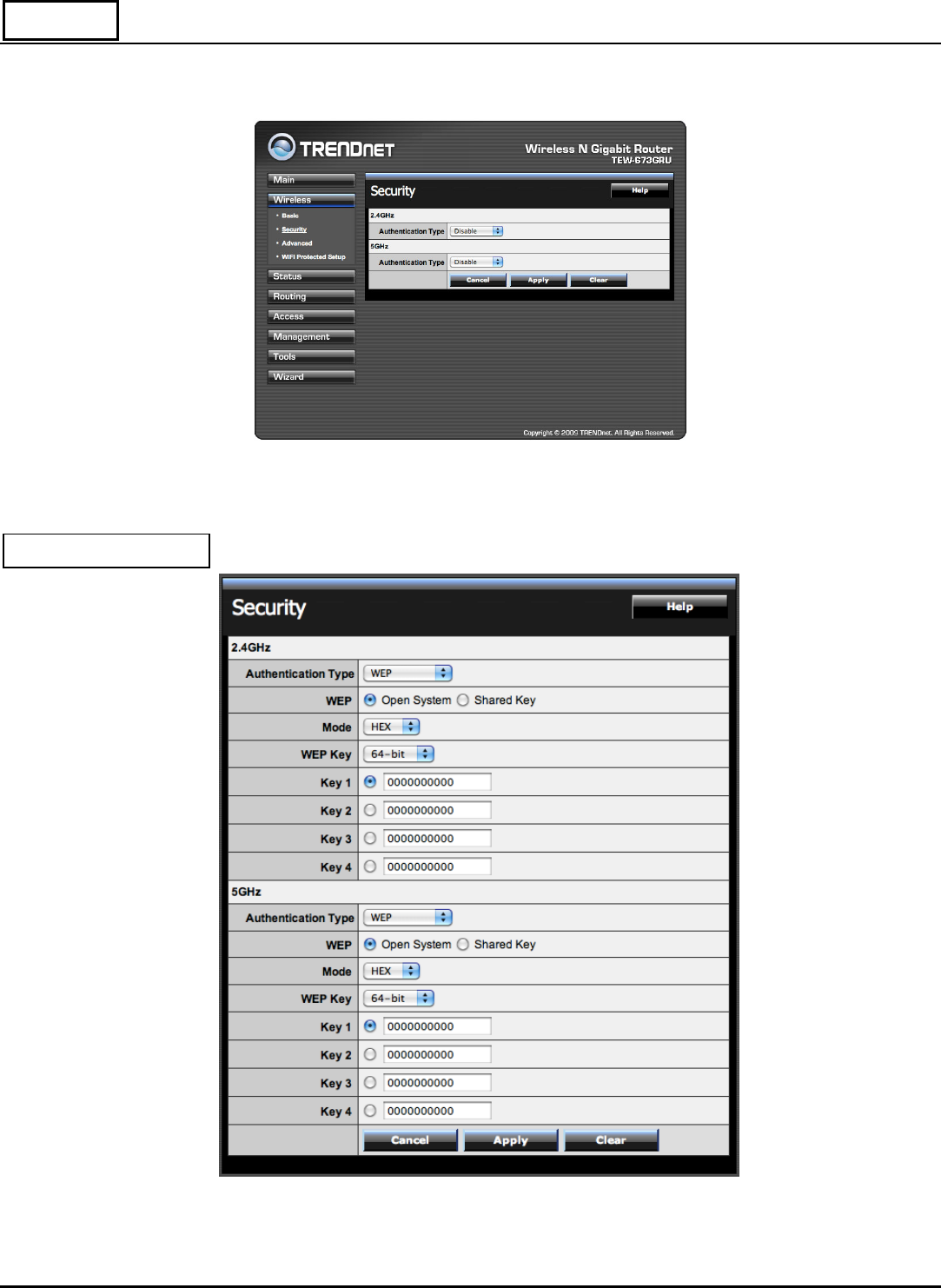
31
Security
This page allows users to set the wireless security of the WLAN router for a secure
wireless communication.
Authentication Type: The authentication type is set to Disable by default. There
are four options: Disabled, WEP, WPA, WPA2 and WPA-Auto.
WEP Encryption
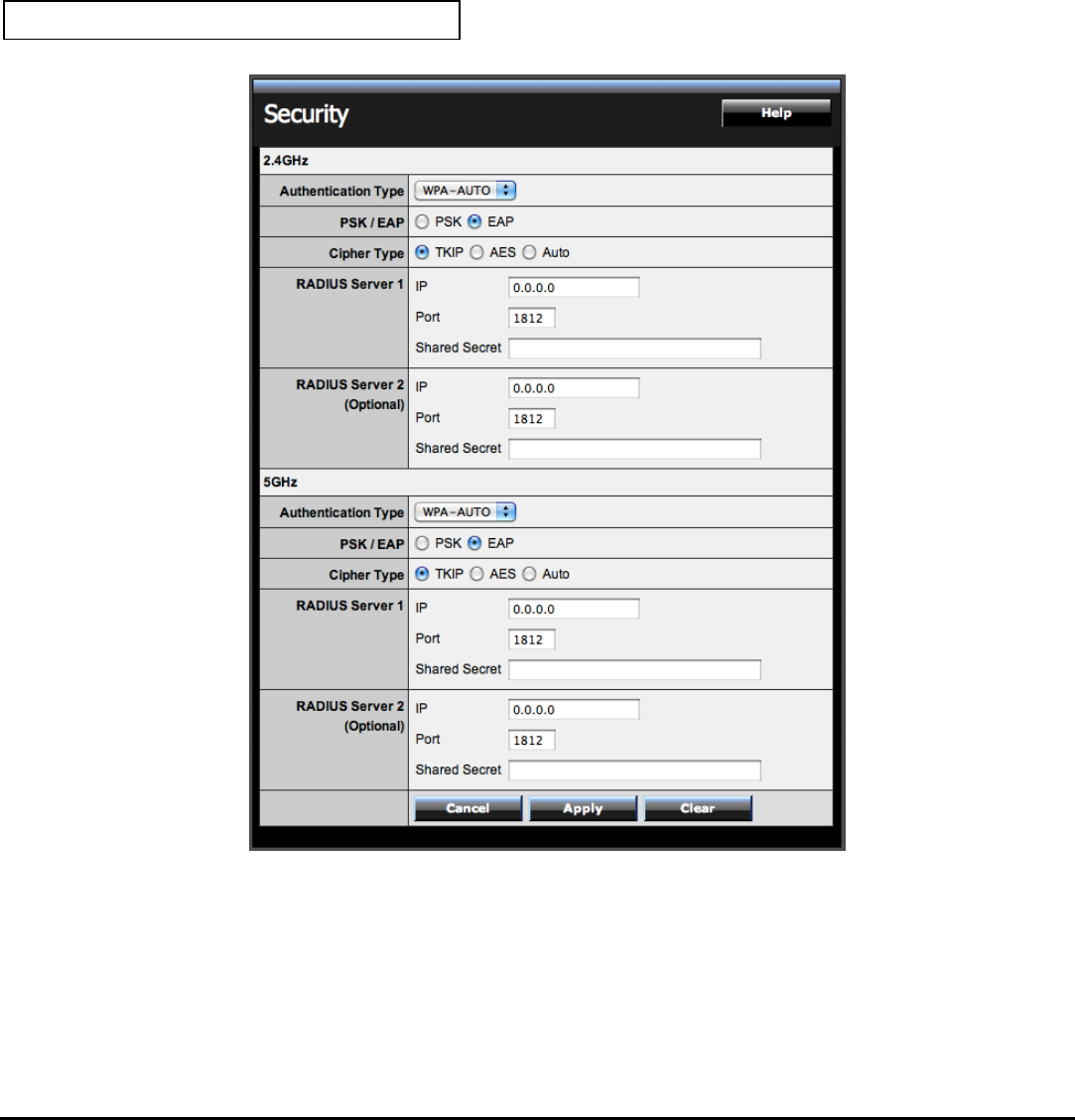
32
WEP: Open System and Shared Key requires the user to set a WEP key to
exchange data with other wireless clients that have the same WEP key.
Mode: Select the key type: ASCII or HEX
WEP Key: Select the level of encryption from the drop-down list. The WLAN
Router supports, 64 and 128-bit encryption.
Key 1 ~ Key 4: Enables users to create up to 4 different WEP keys. Manually
enter a set of values for each key. Select a key to use by clicking the radio button
next to the key.
WPA/WPA2/WPA-Auto Security
If WPA, WPA2 or WPA-Auto EAP is selected, the above screen is shown. Please
set the length of the encryption key and the parameters for the RADIUS server.
Cipher Type: Select the cipher type for TKIP or AES encryption, Selected Auto
for auto detects the cipher type.
RADIUS Server:
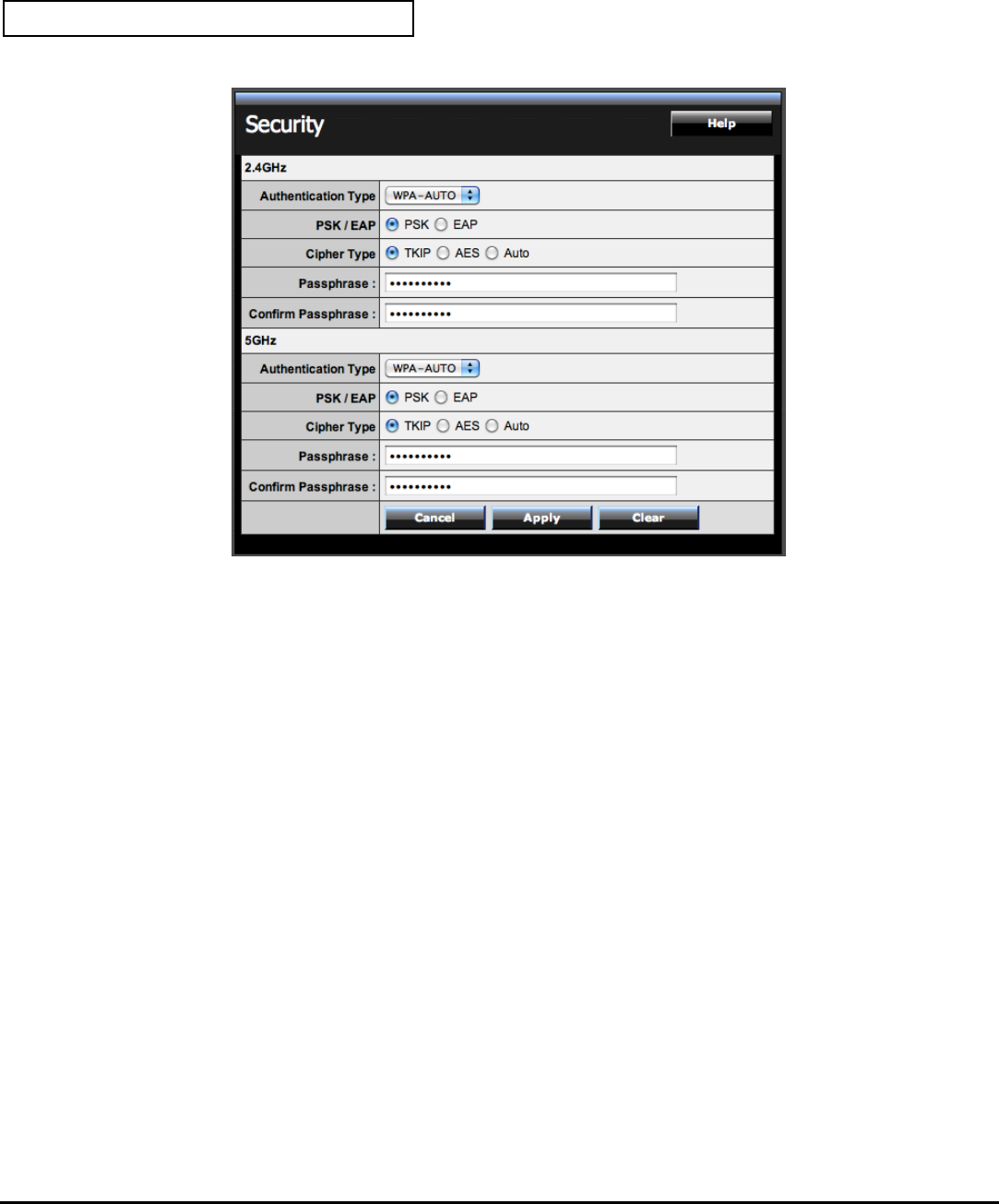
33
1. Enter the IP address, Port used and Shared Secret by the Primary Radius
Server.
2. Enter the IP address, Port used and Shared Secret by the Secondary Radius
Server. (optional)
WPA-PSK/WPA2-PSK Security
If WPA, WPA2 or WPA-Auto PSK is selected the below screen will show.
Cipher Type: Select the cipher type for TKIP or AES encryption, Select Auto for
auto detects the cipher type.
Passphrase: Enter a passphrase key, the length should be 8 characters at least.
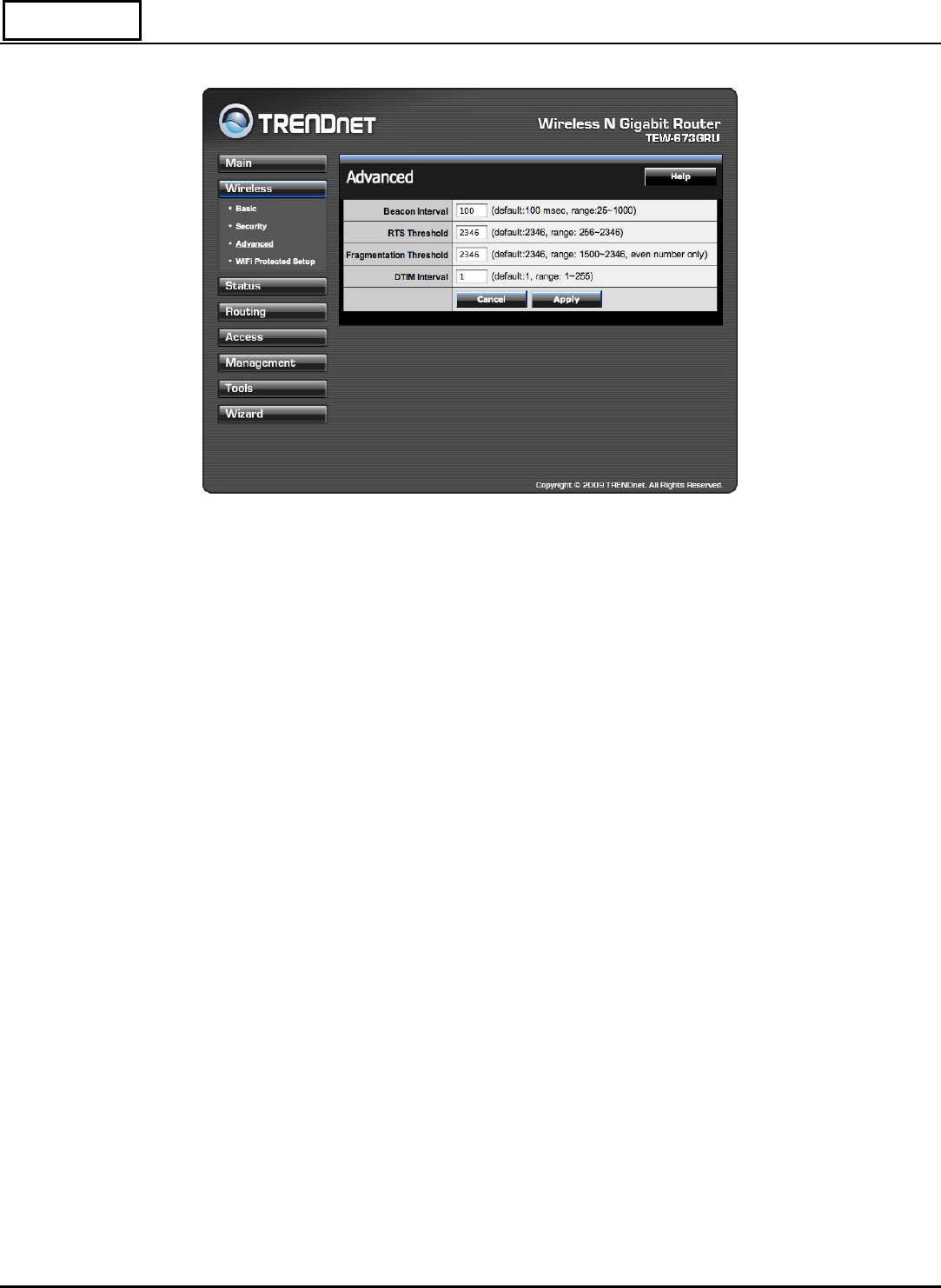
34
Advanced
This screen enables users to configure advanced wireless functions.
Beacon Interval: Type the beacon interval in the text box. User can specify a value
from 25 to 1000. The default beacon interval is 100.
RTS Threshold: Type the RTS (Request-To-Send) threshold in the text box. This
value stabilizes data flow. If data flow is irregular, choose values between 256 and
2346 until data flow is normalized.
Fragmentation Threshold: Type the fragmentation threshold in the text box. If
packet transfer error rates are high, choose values between 1500 and 2346 until
packet transfer rates are minimized. (NOTE: set this fragmentation threshold value
may diminish system performance.)
DTIM Interval: Type a DTIM (Delivery Traffic Indication Message) interval in
the text box. User can specify a value between 1 and 255. The default value is 1.